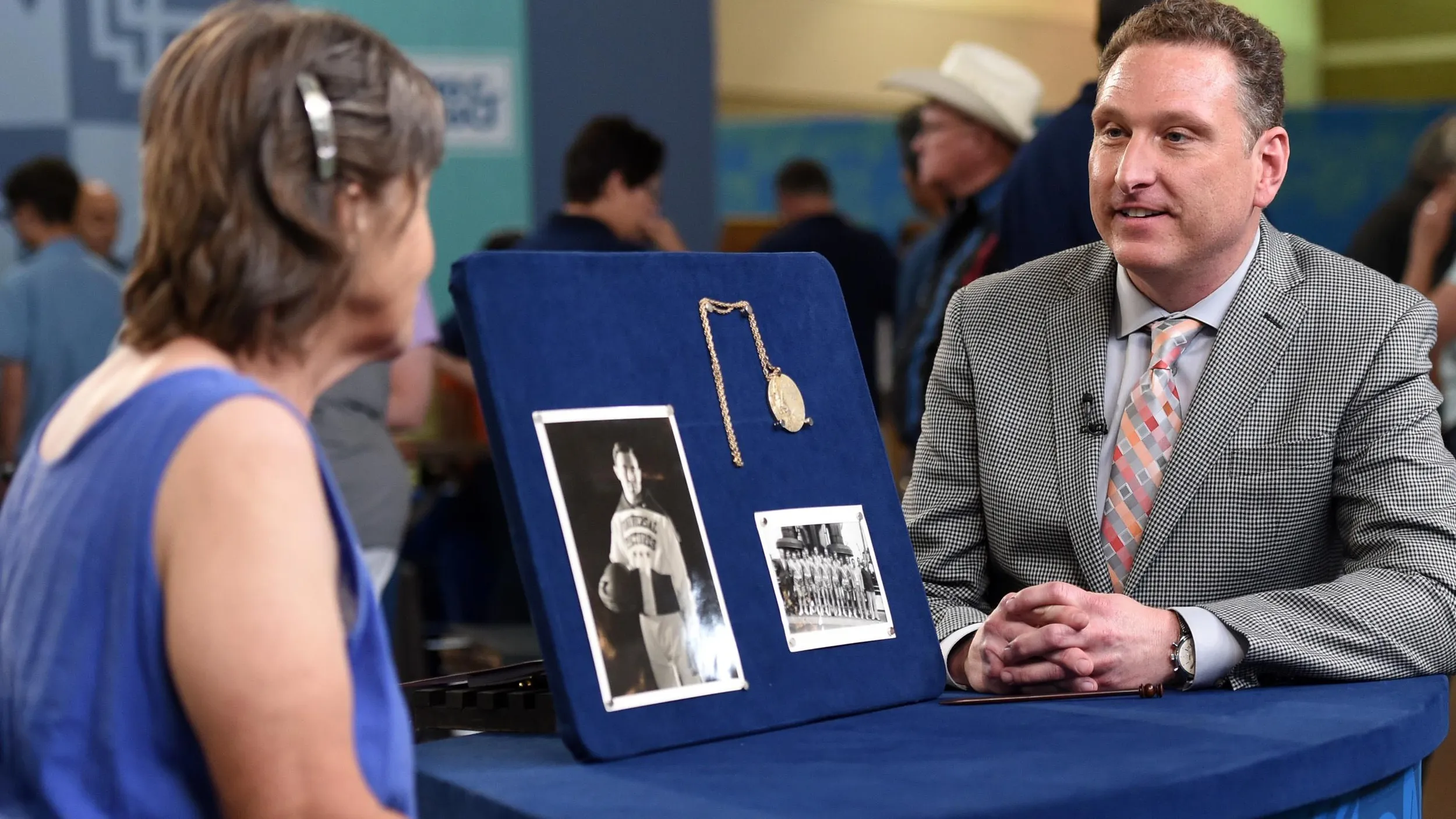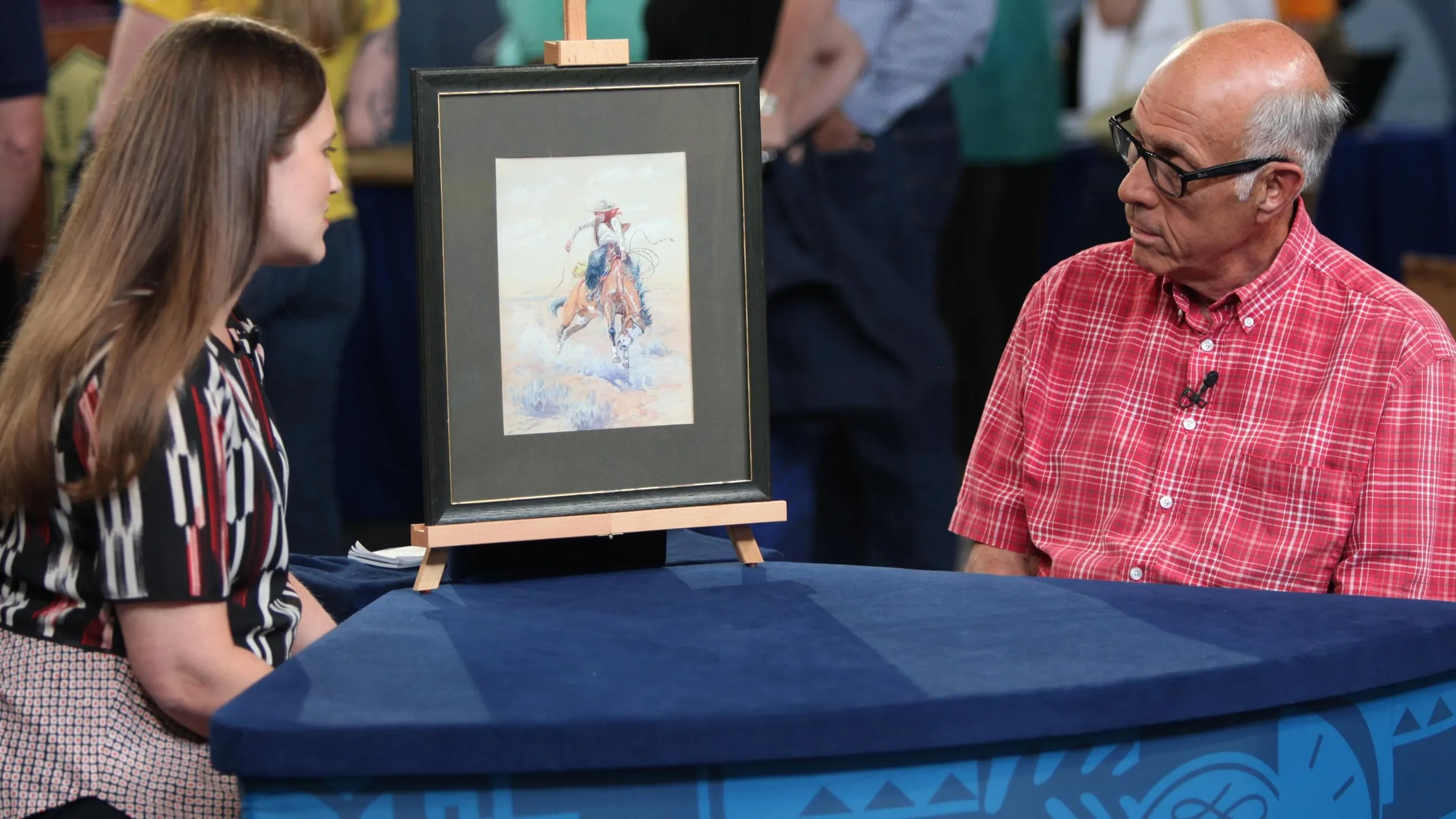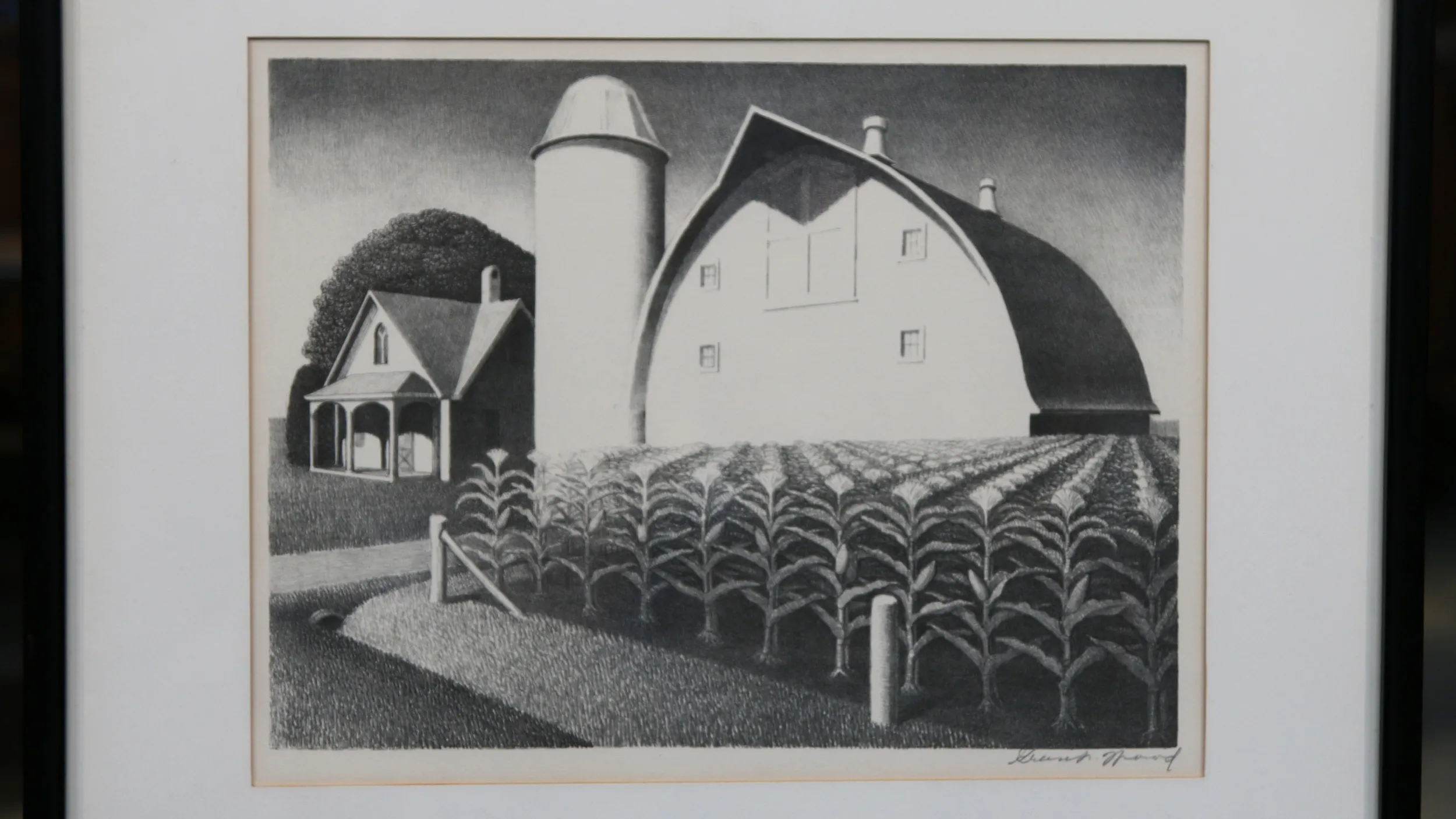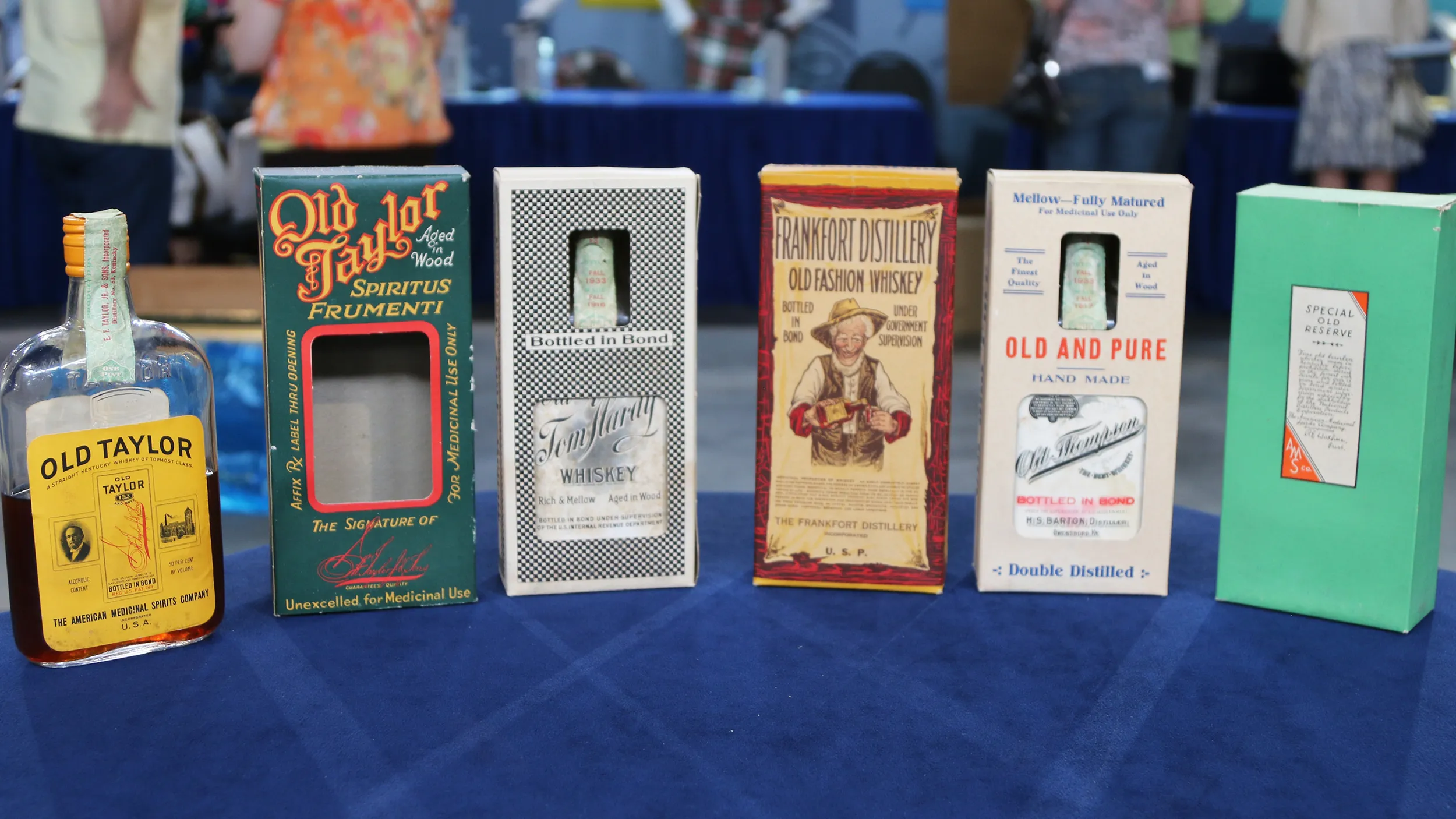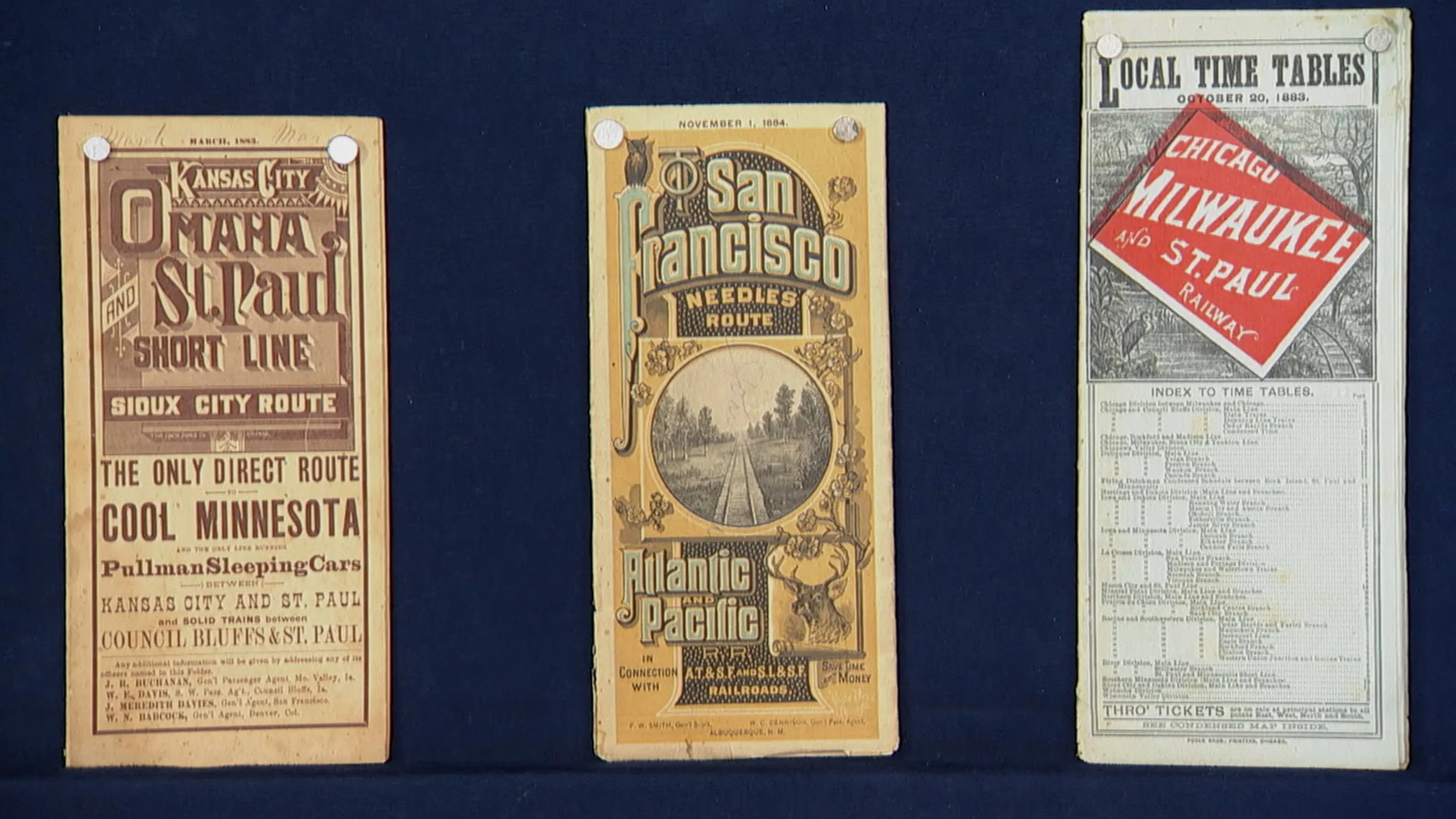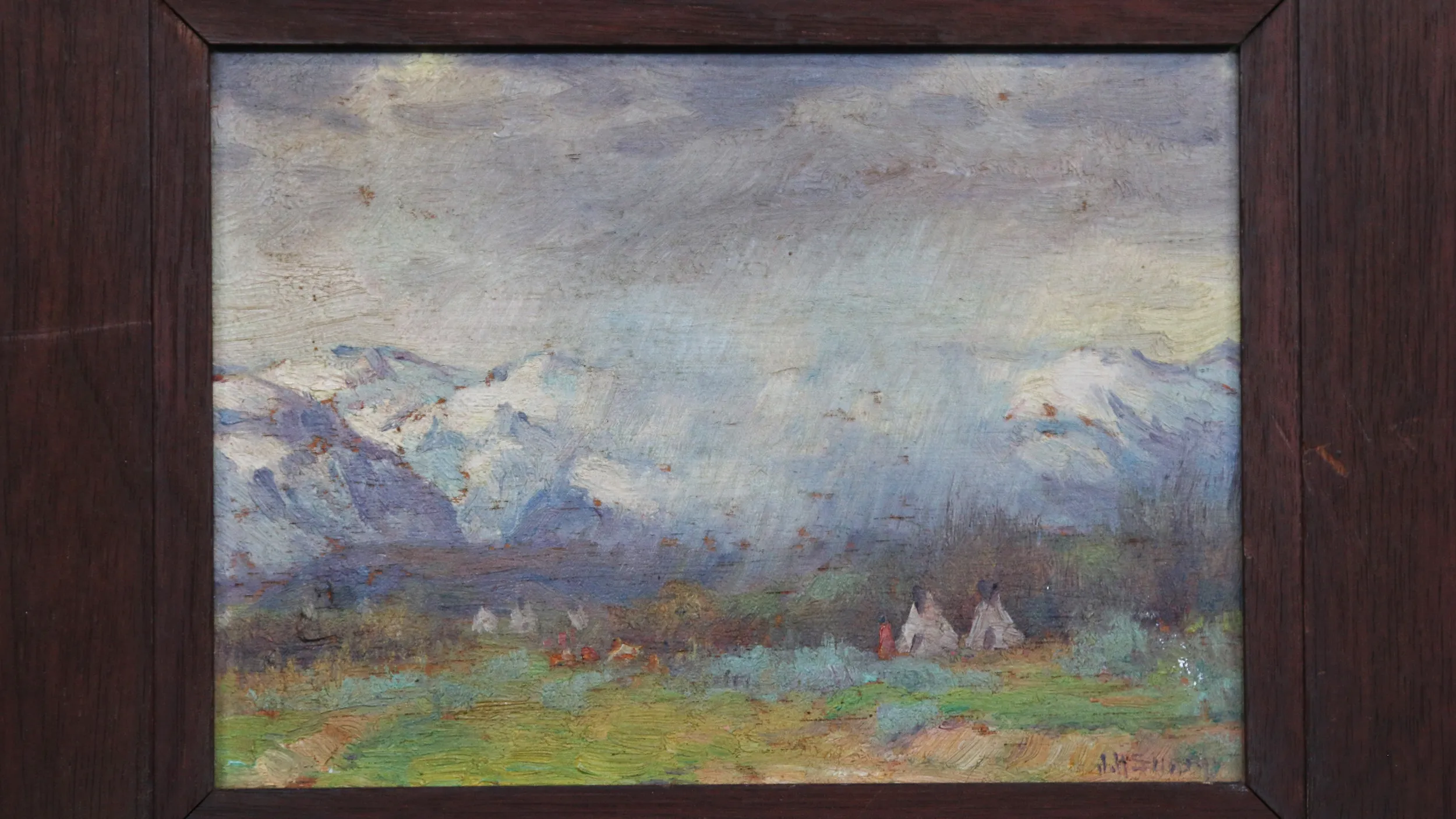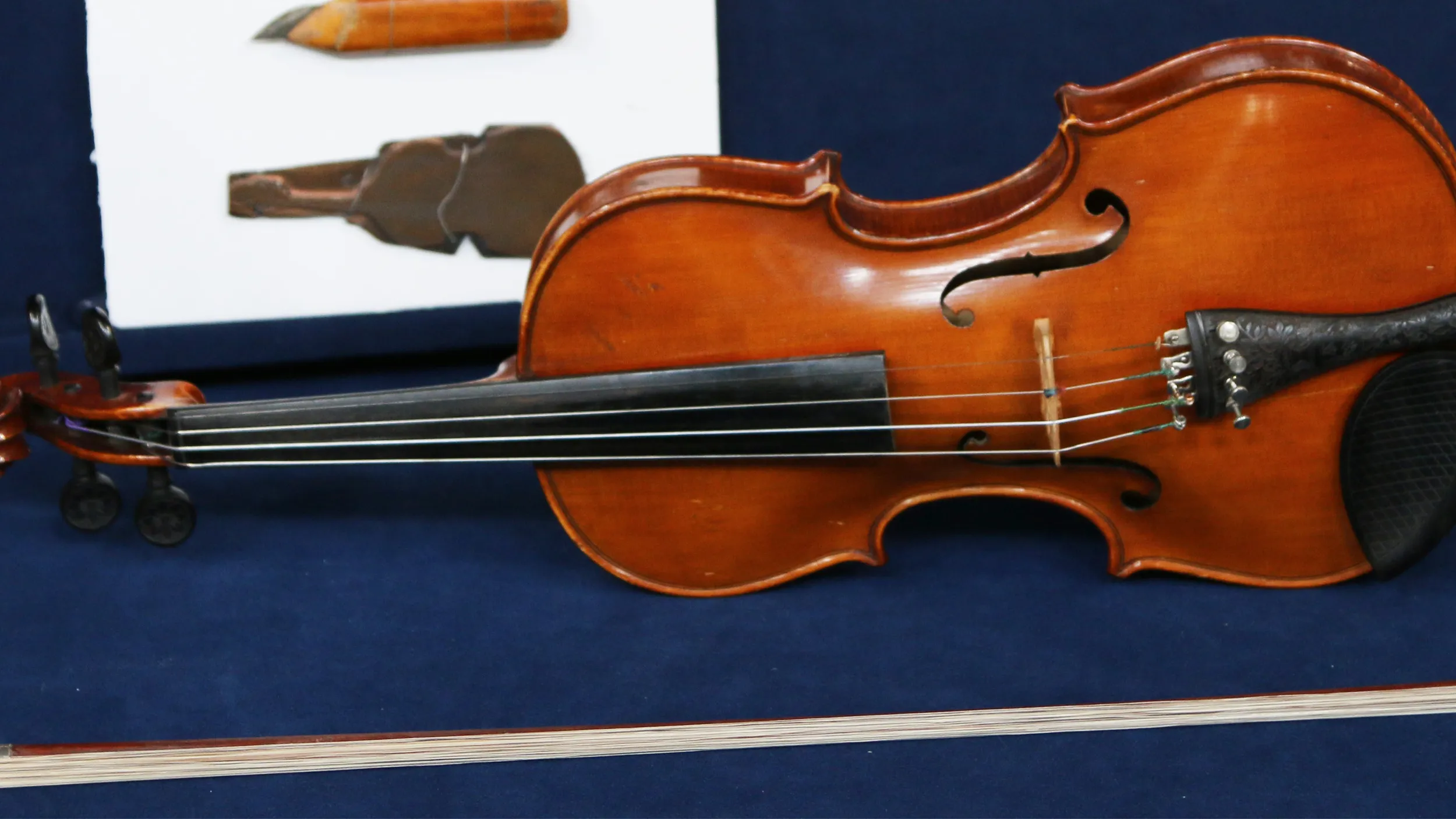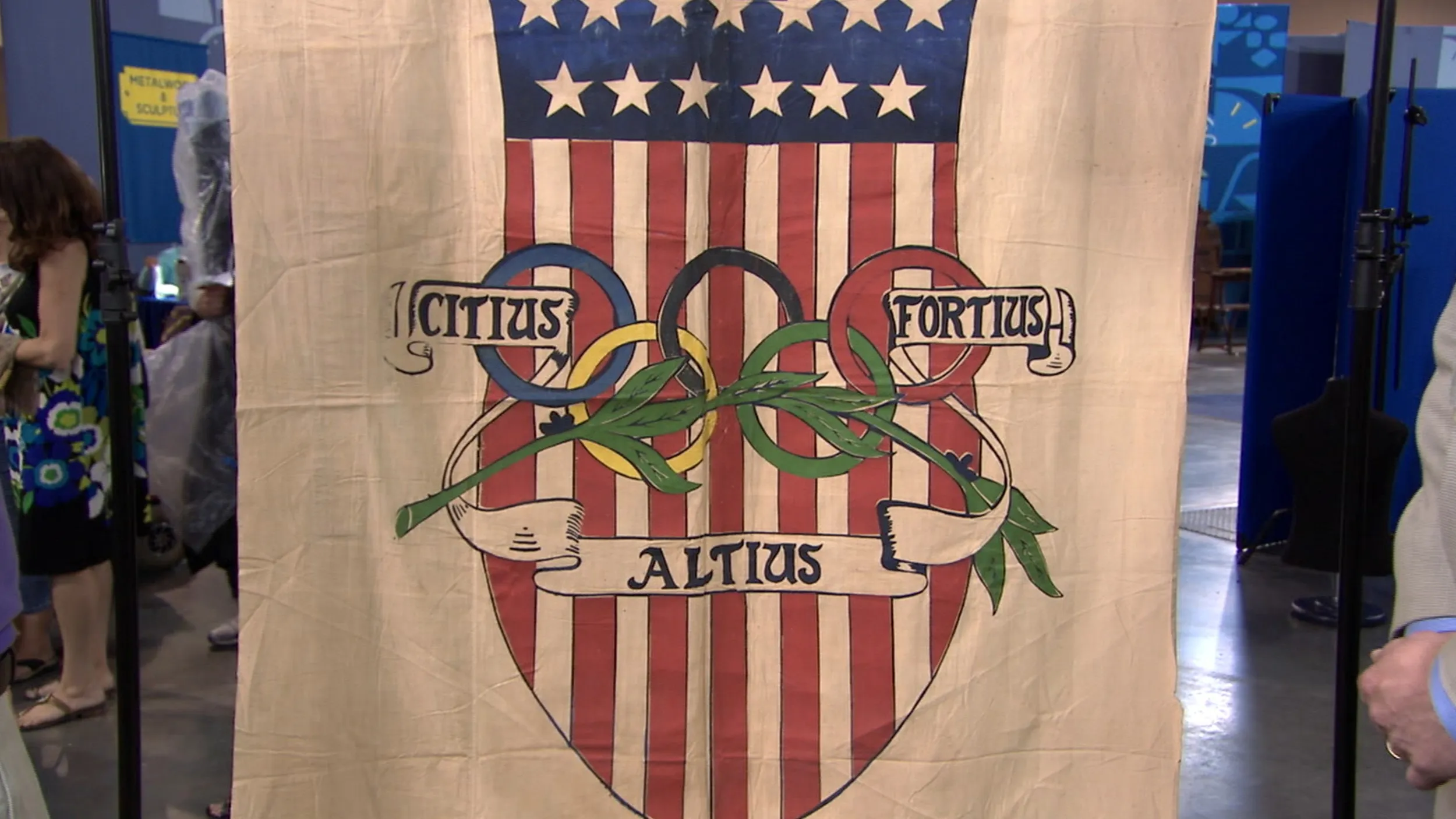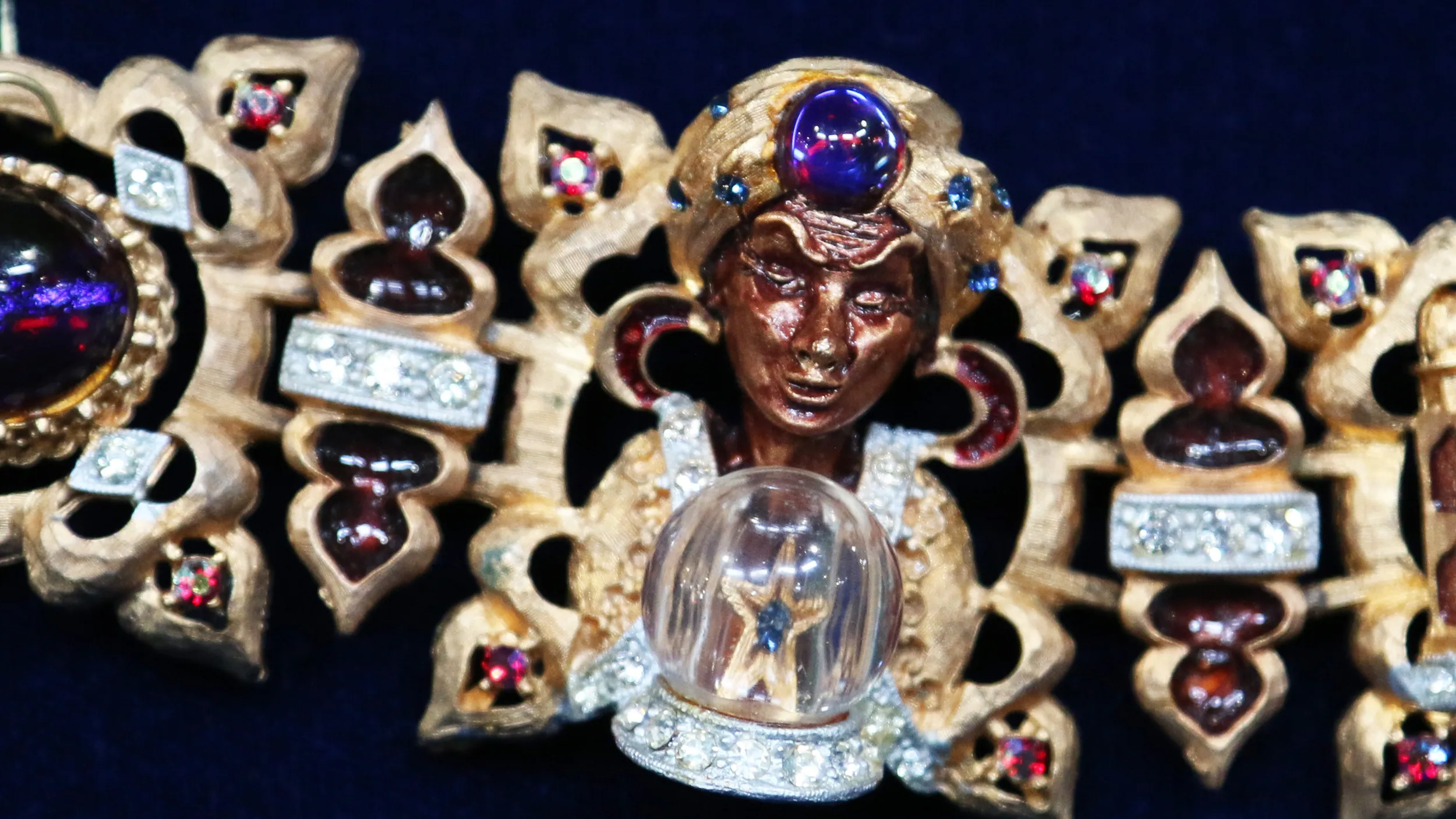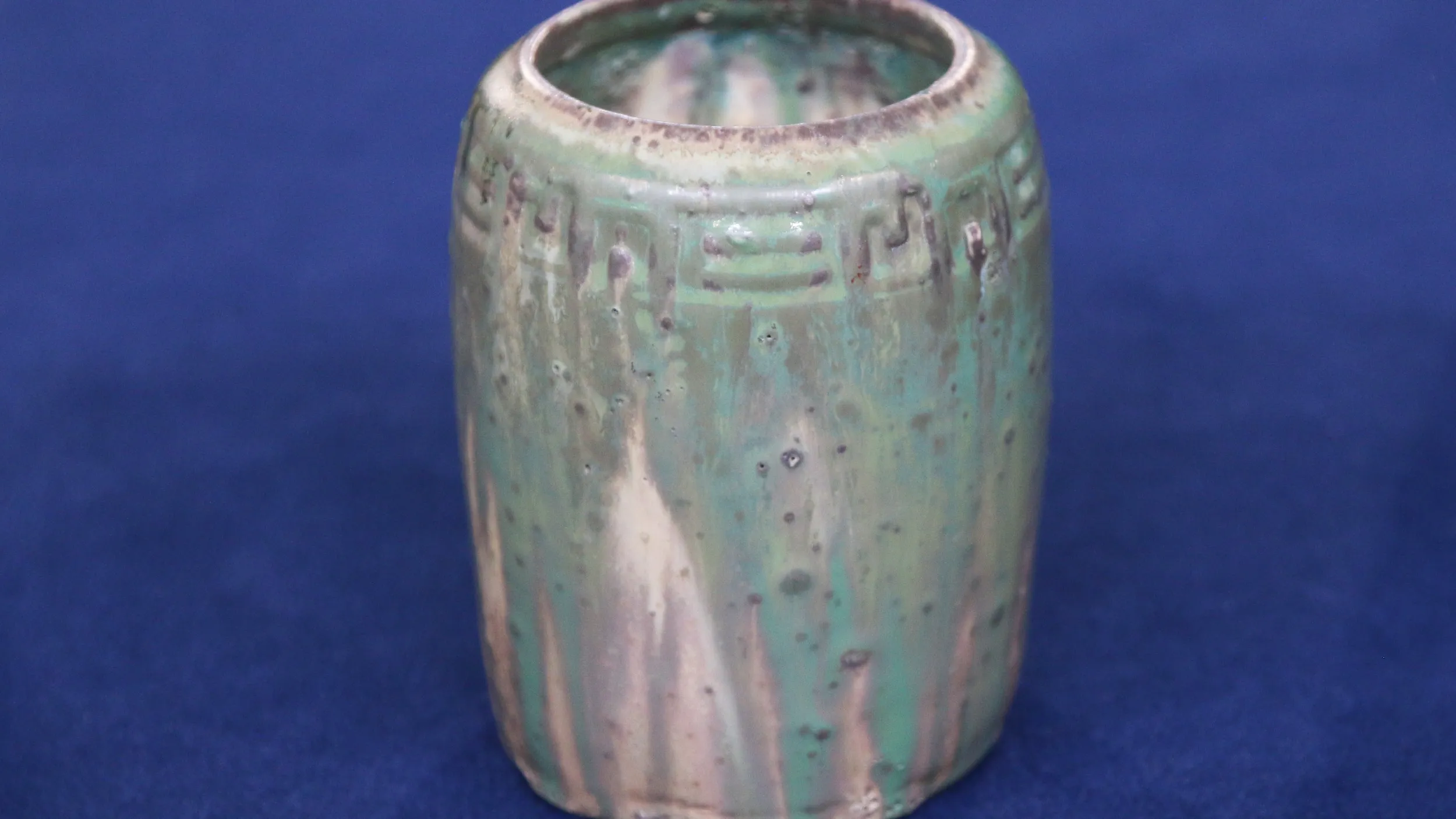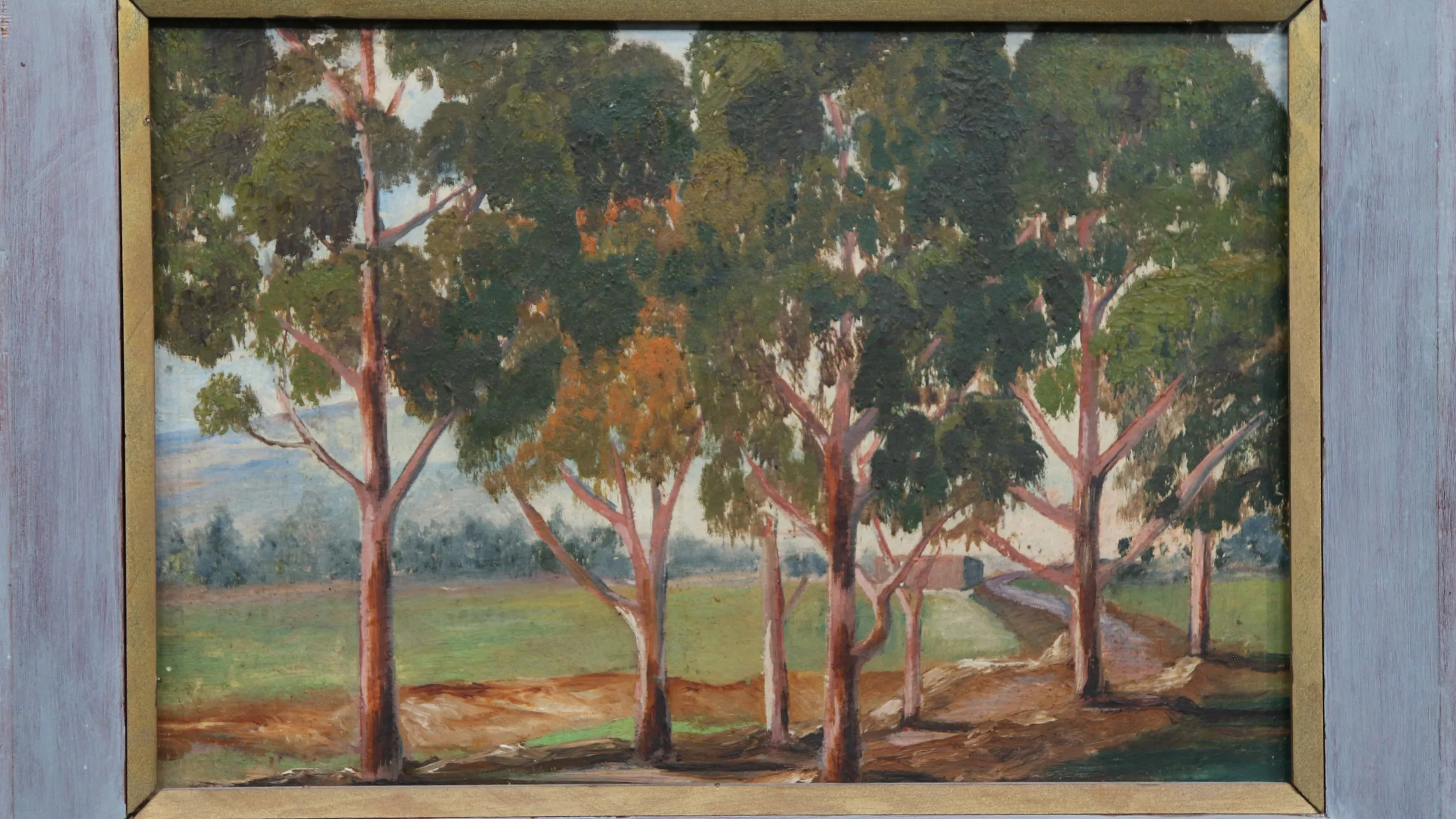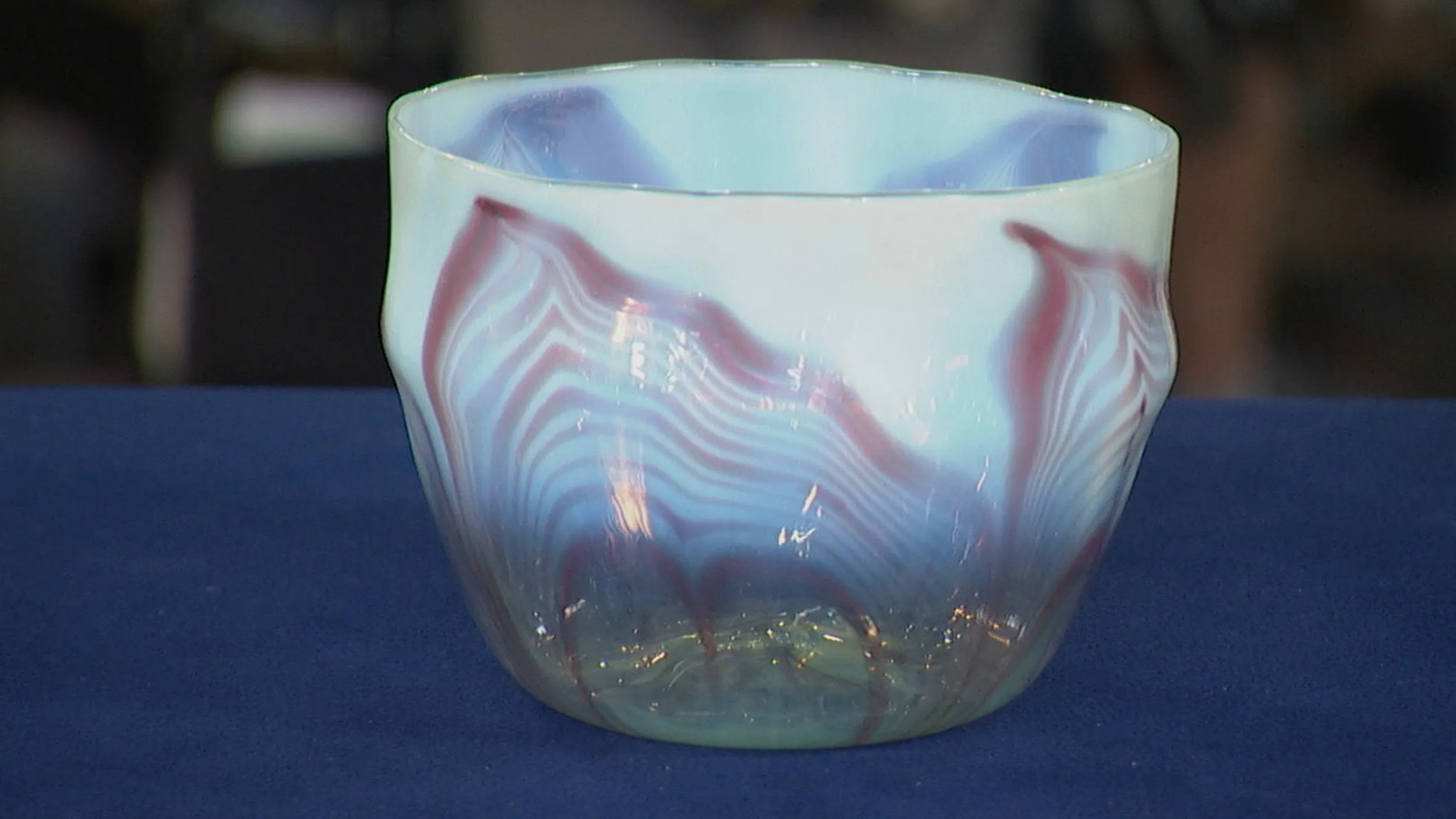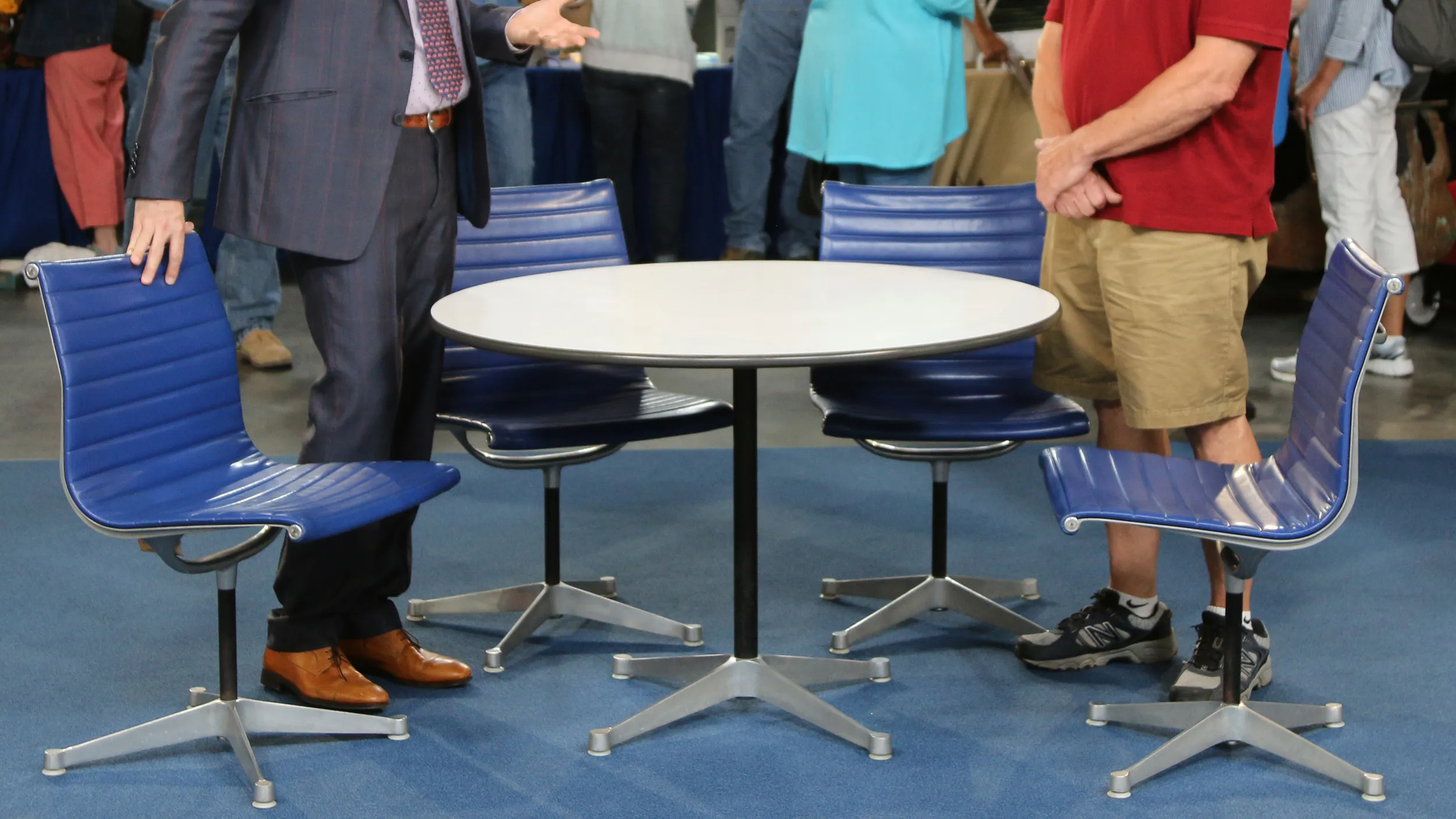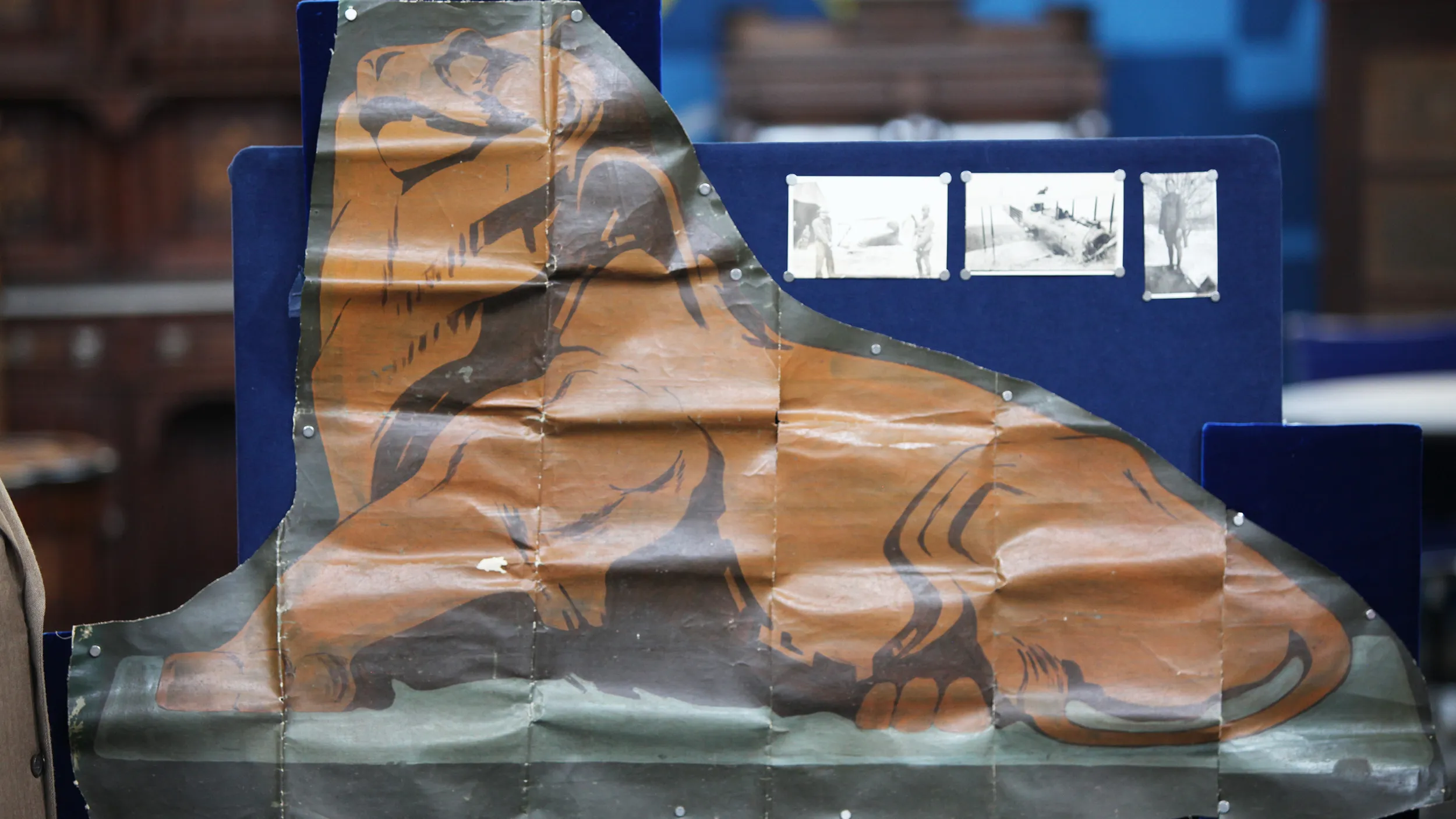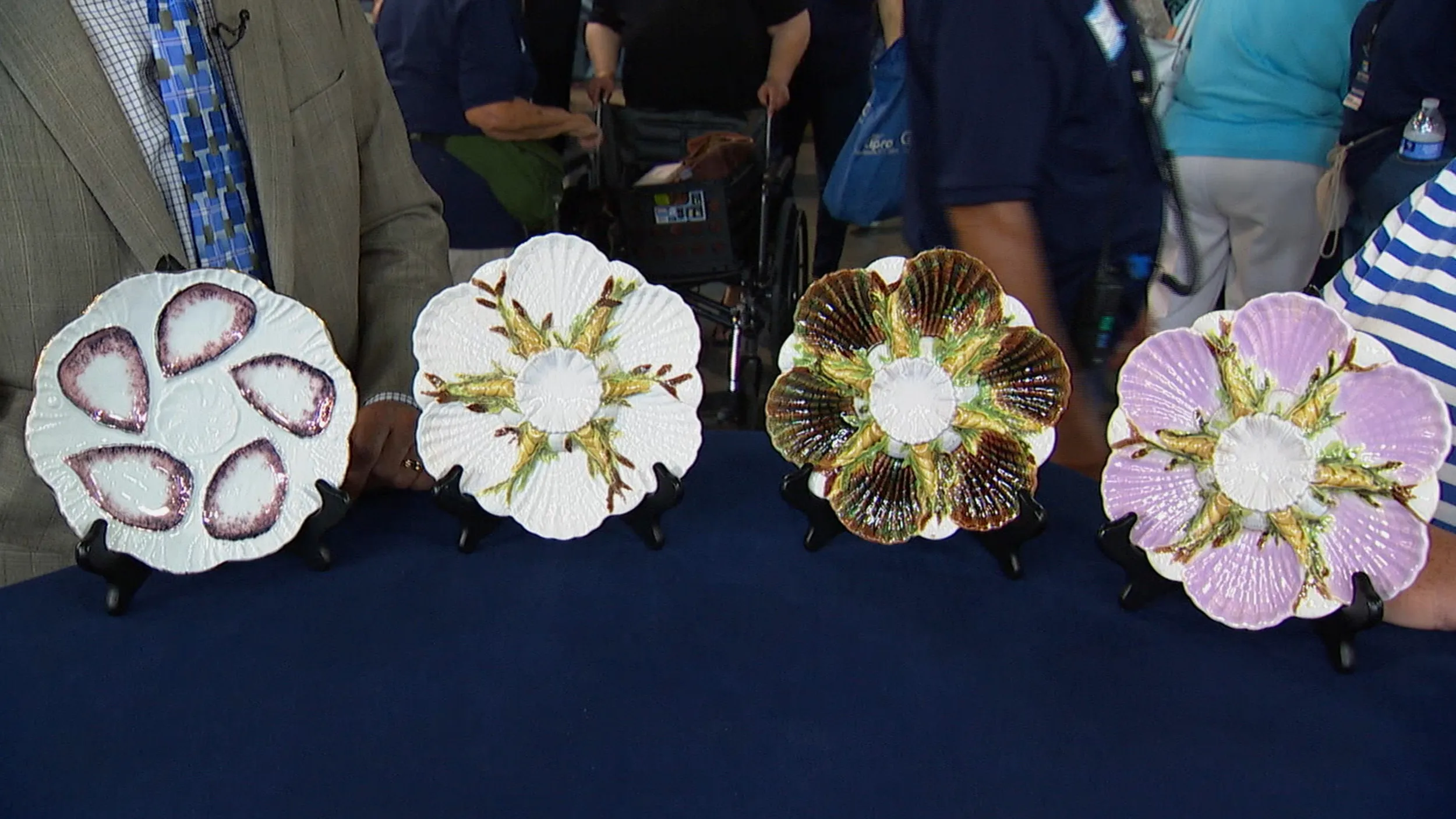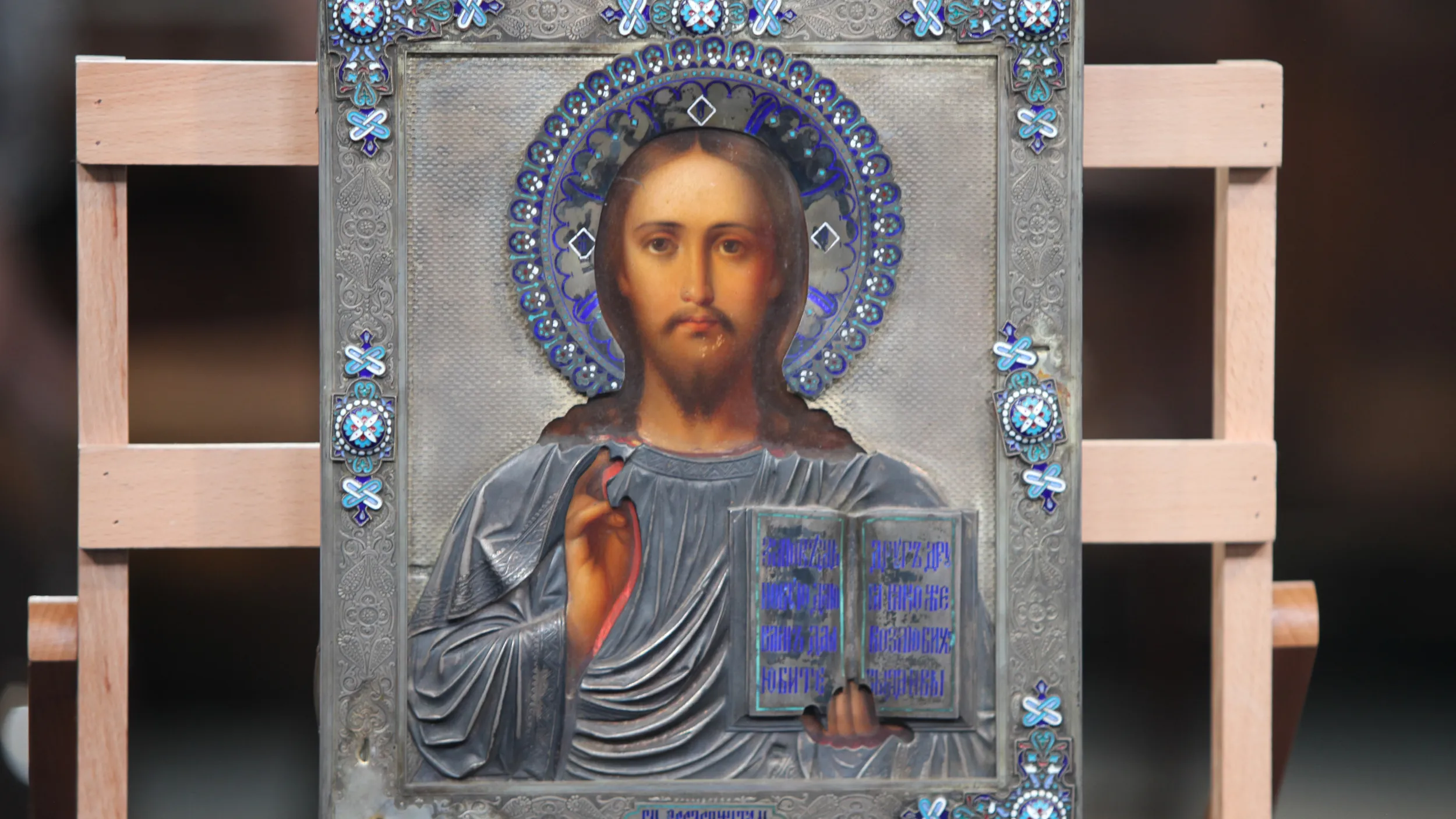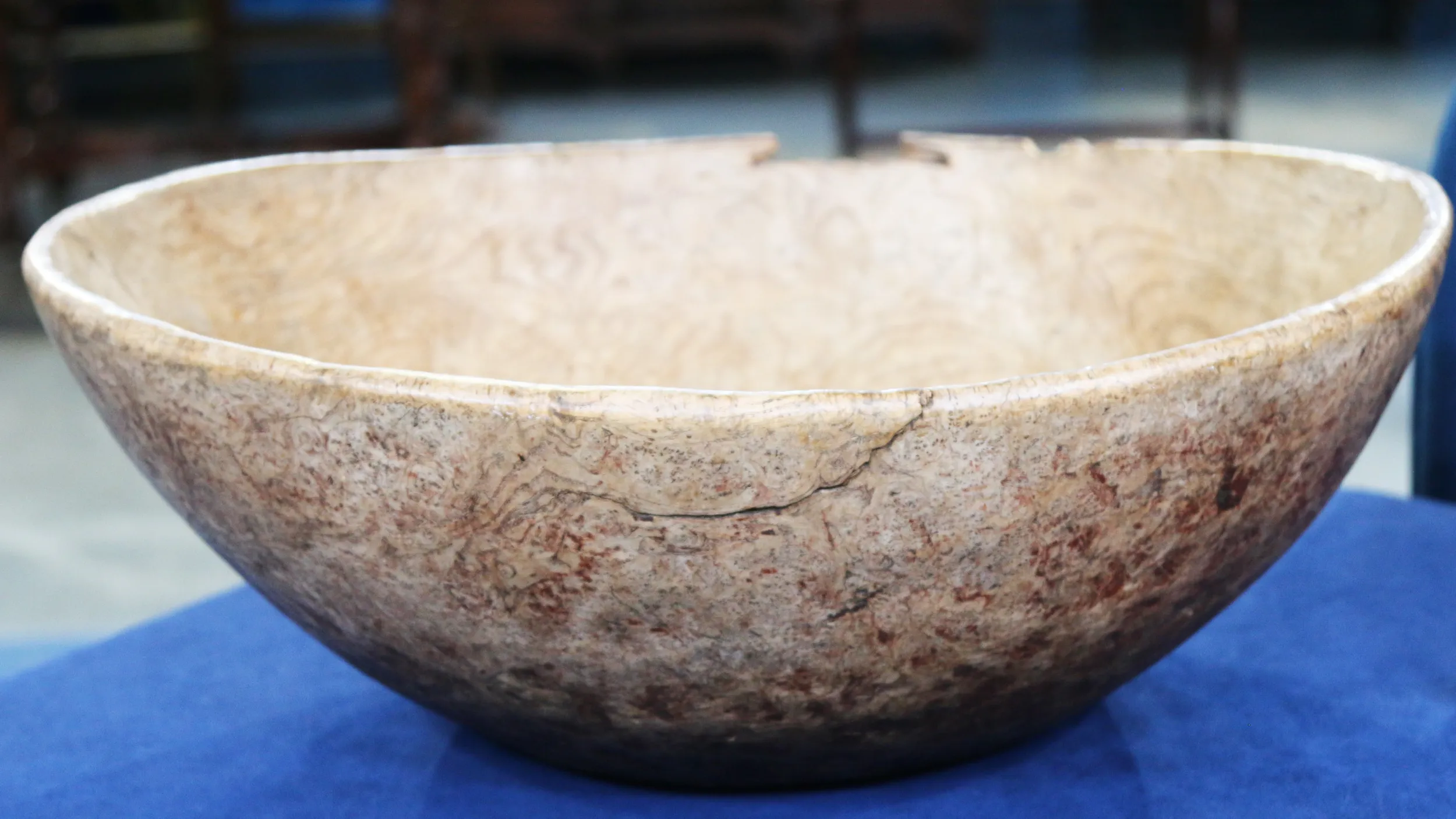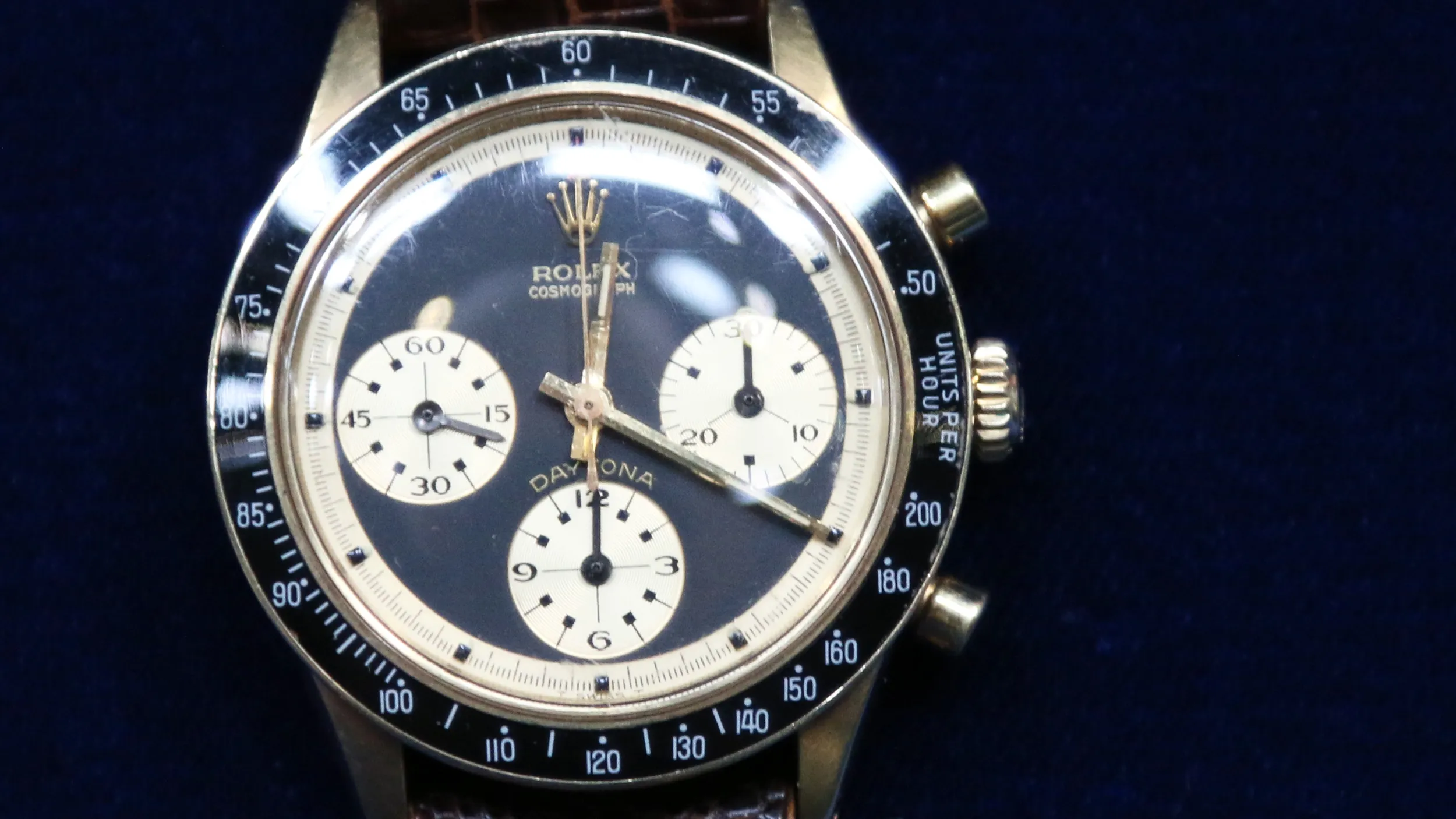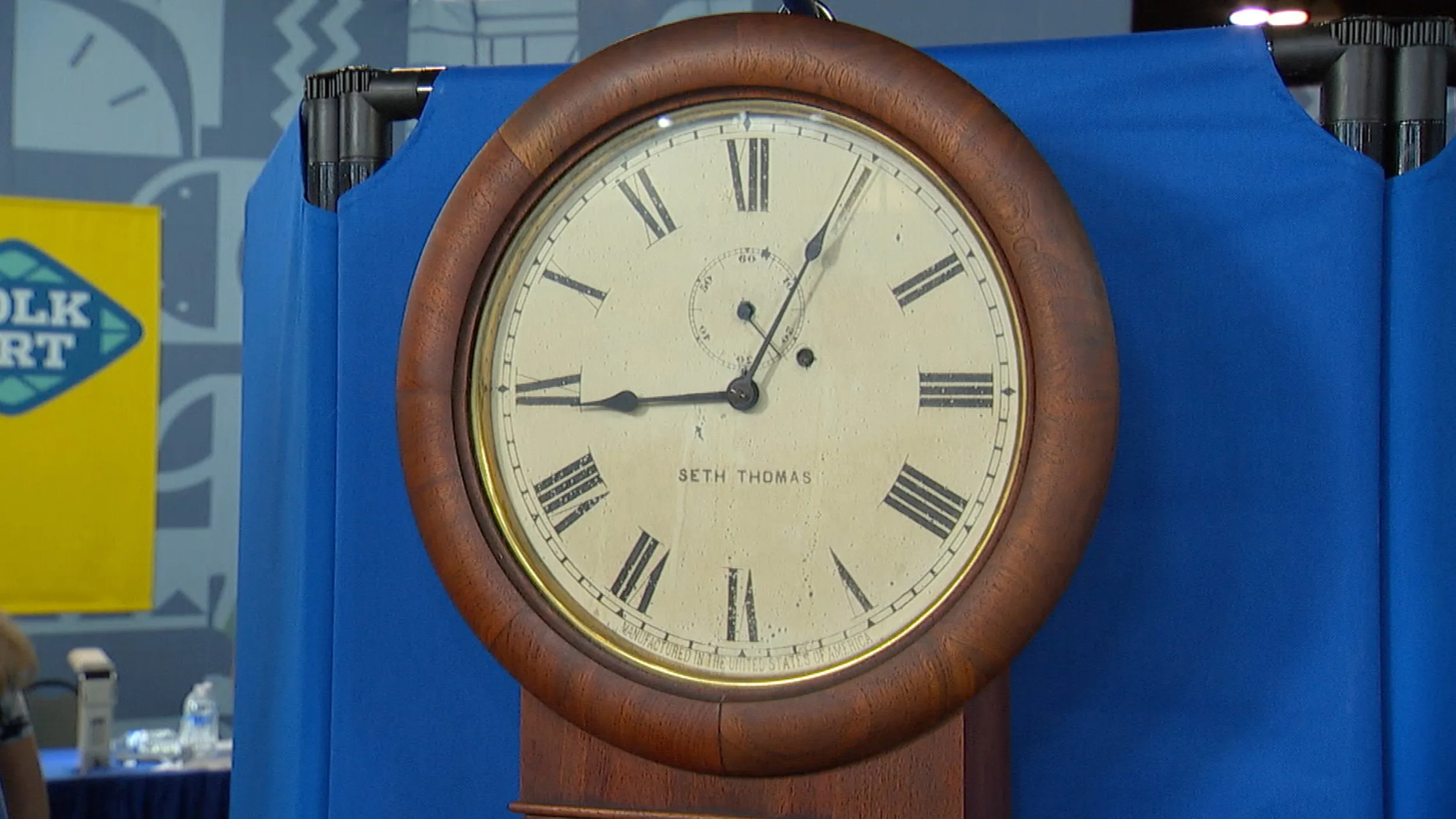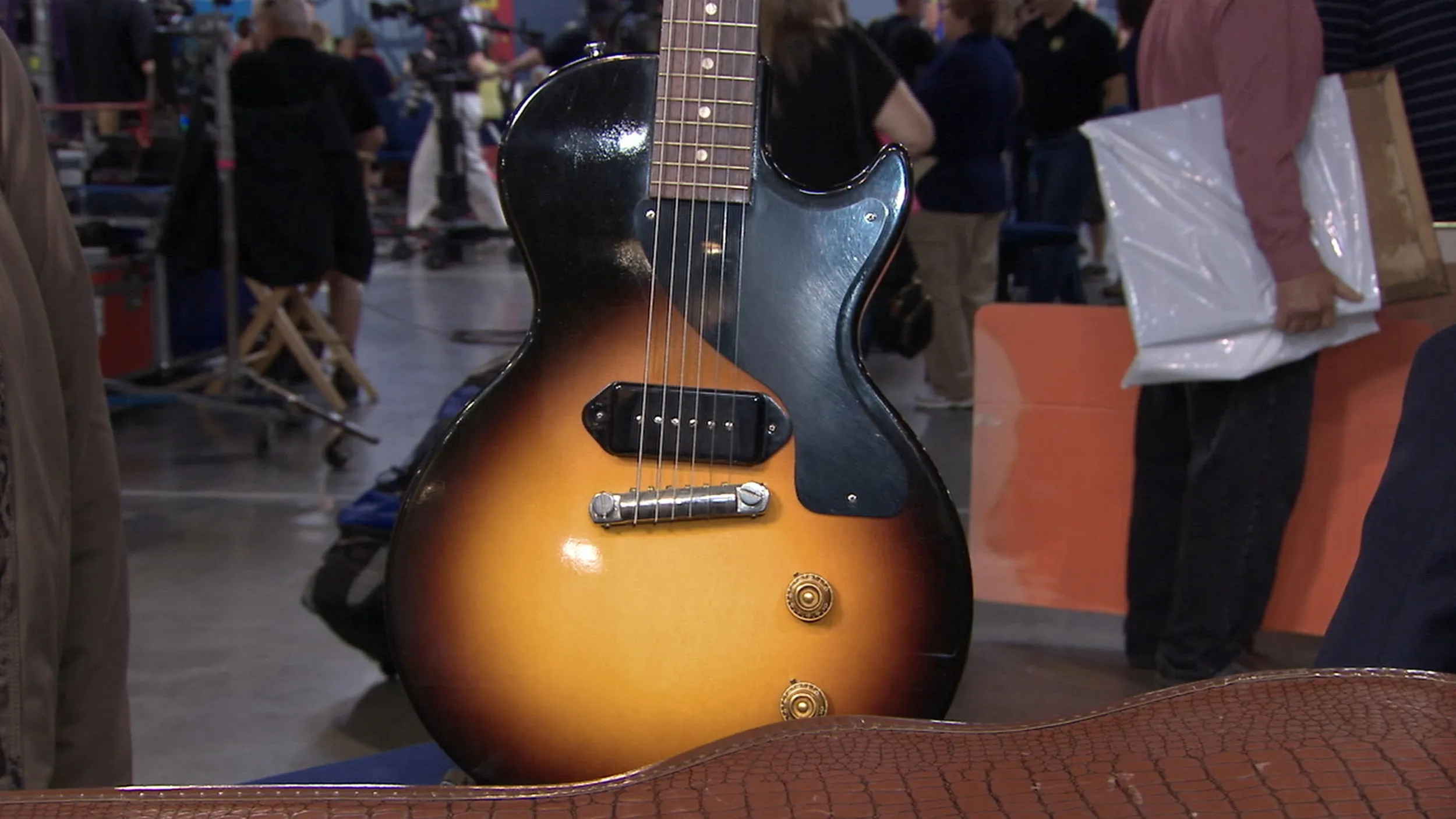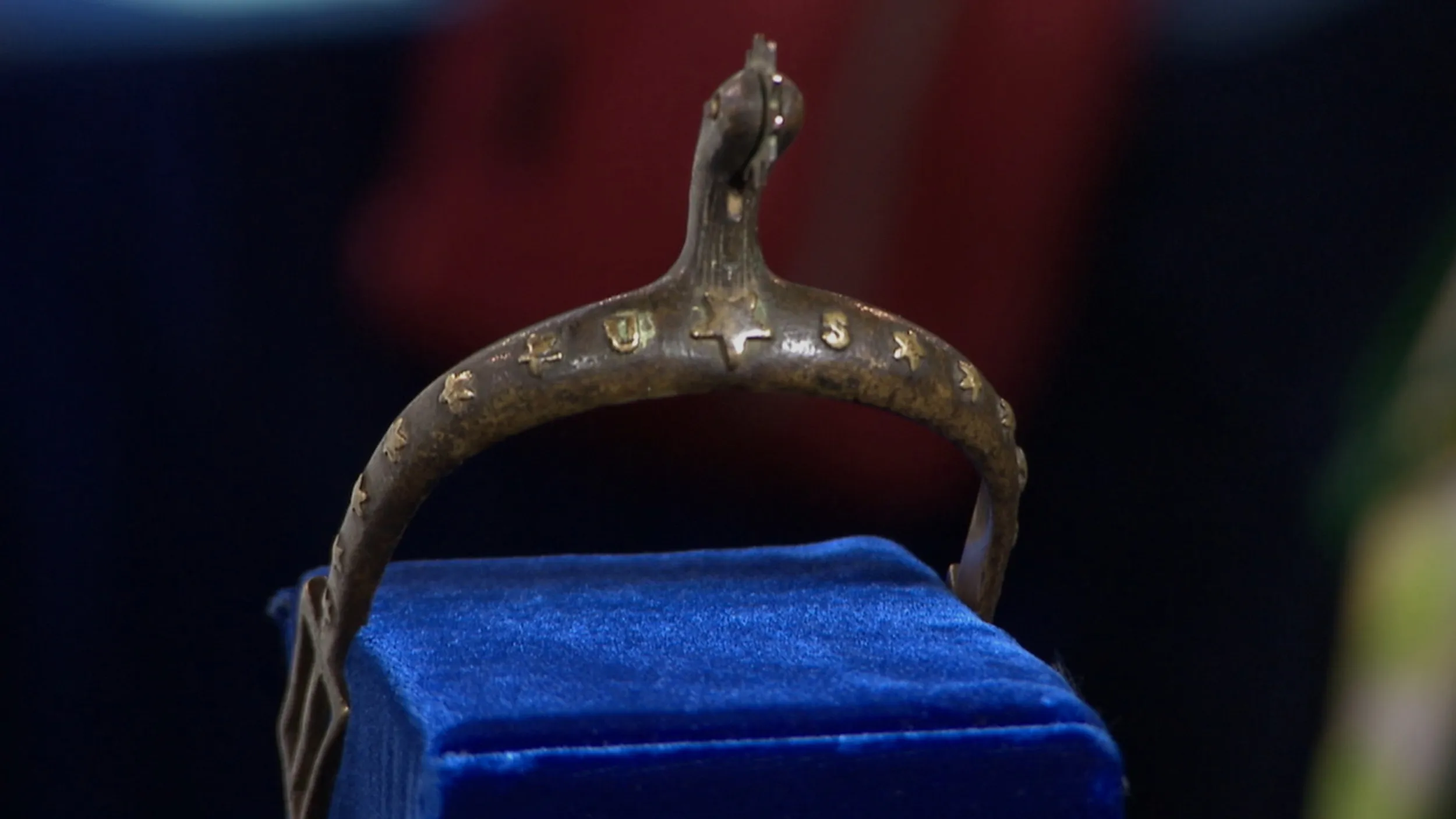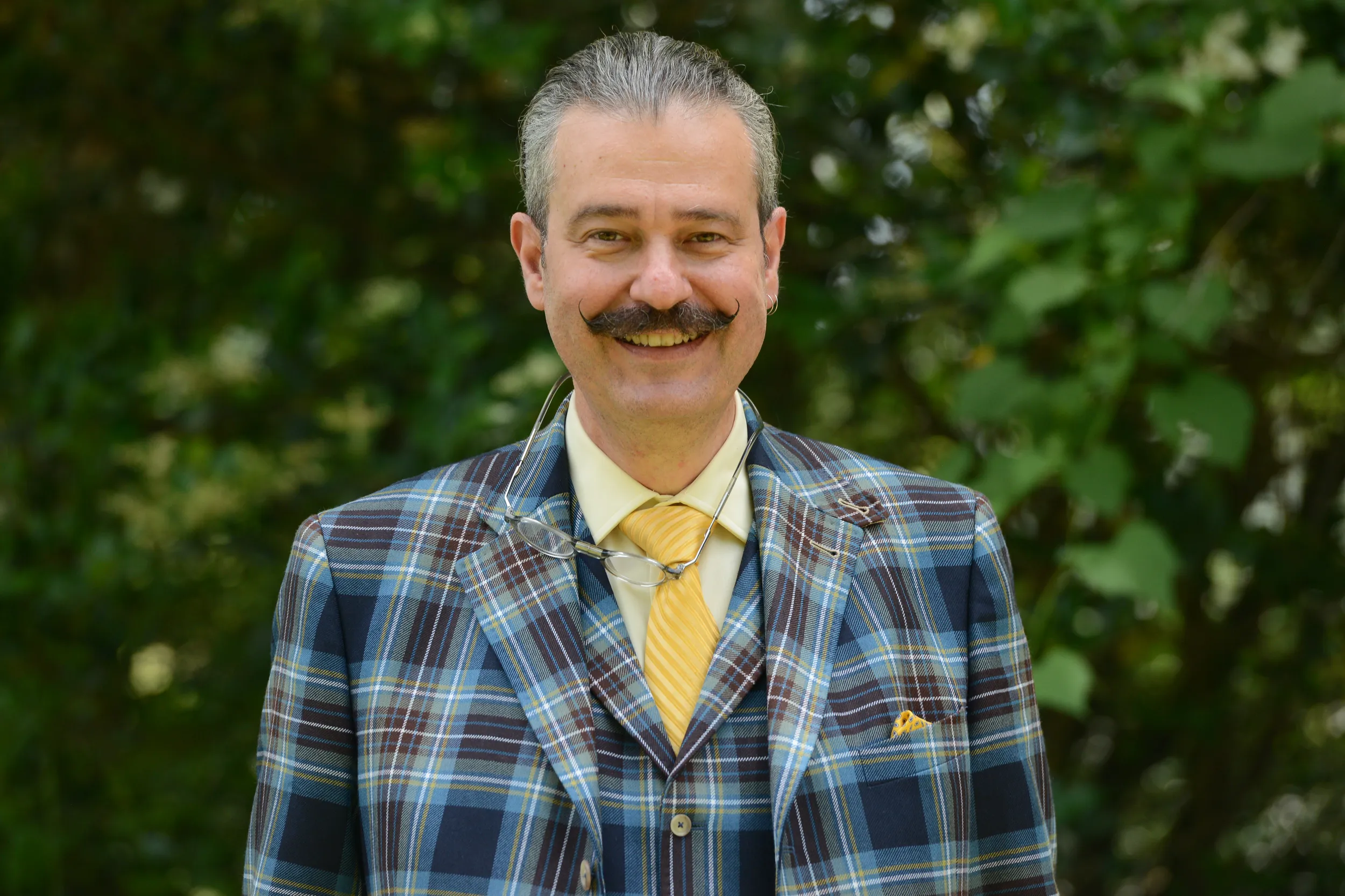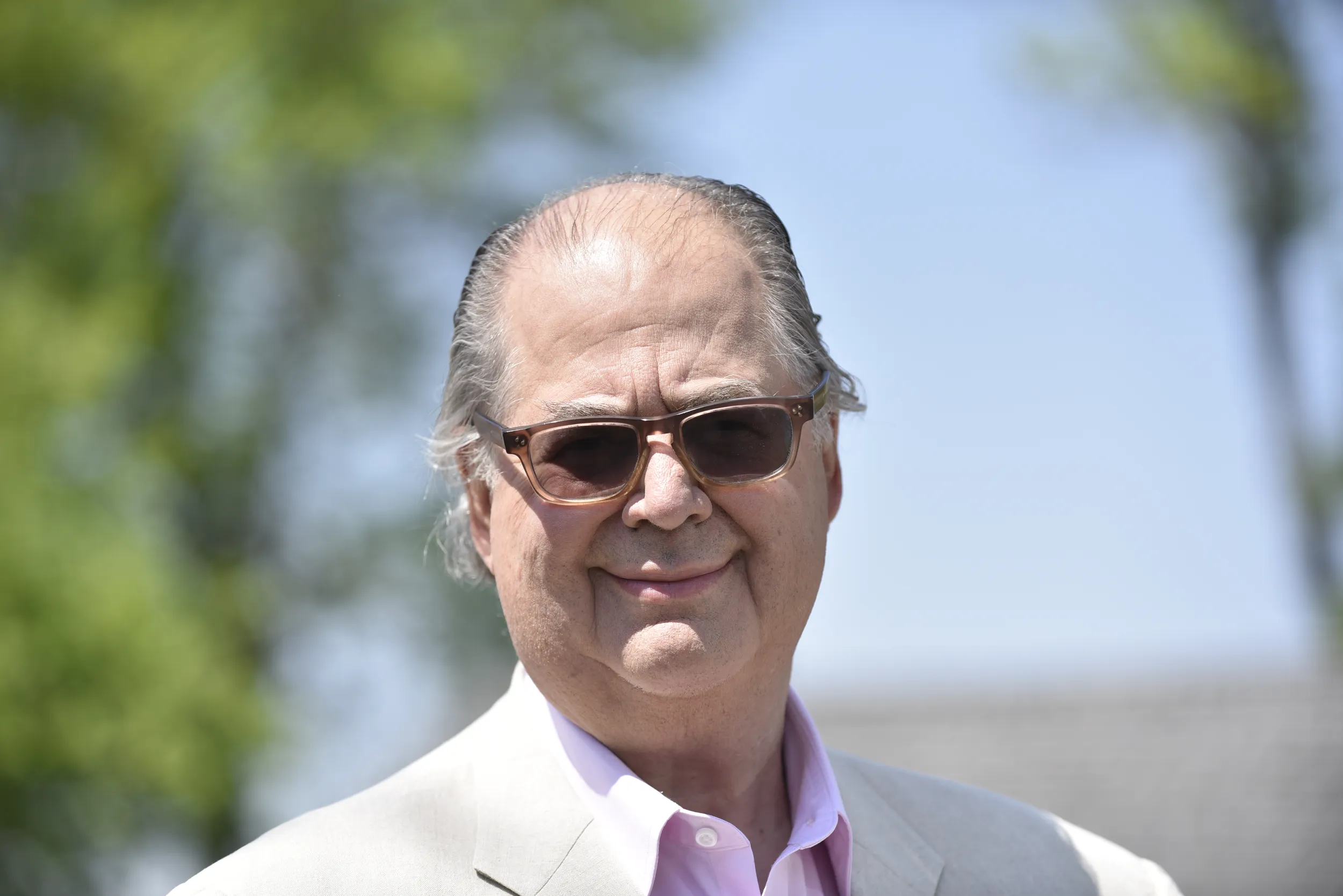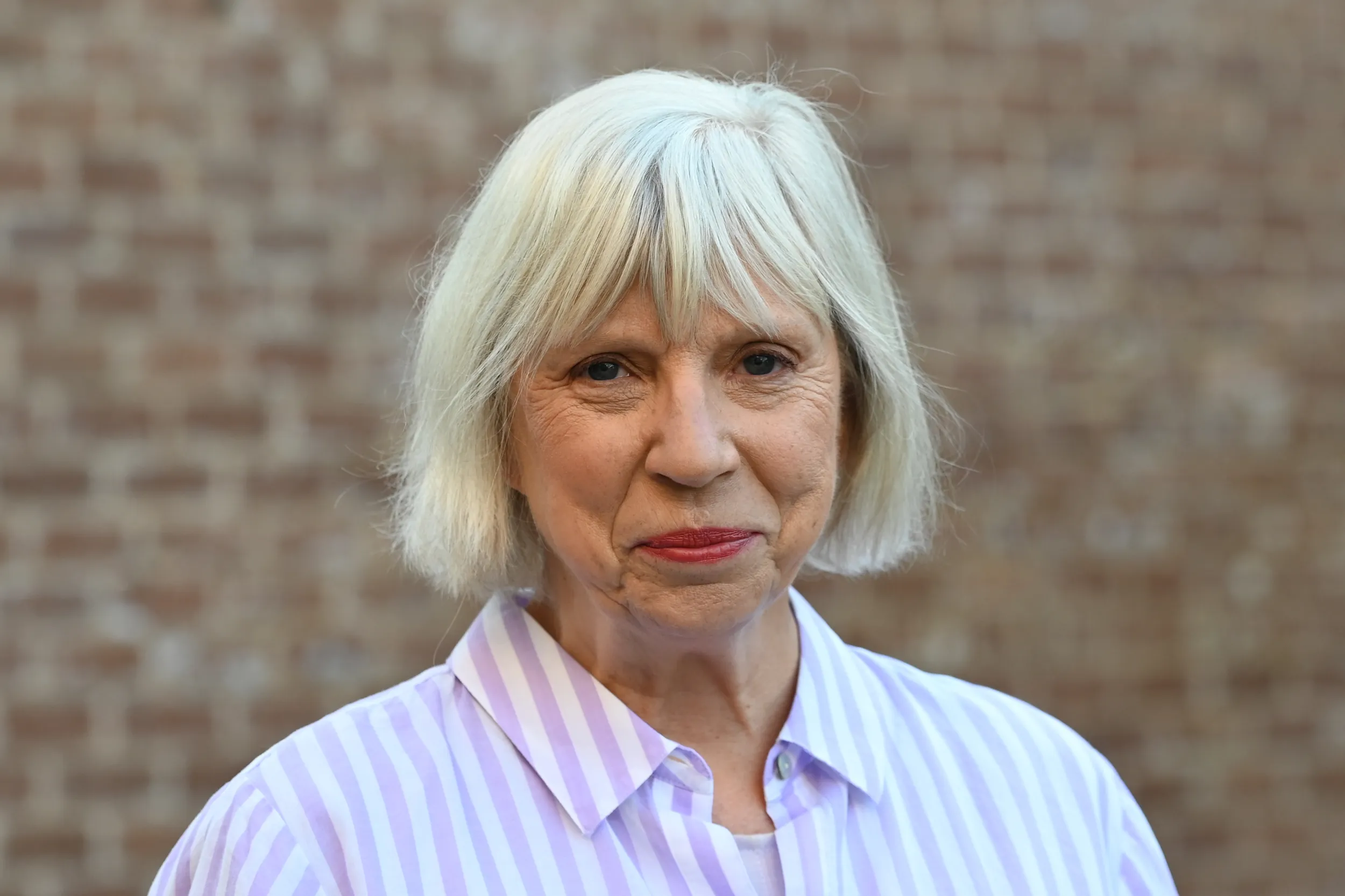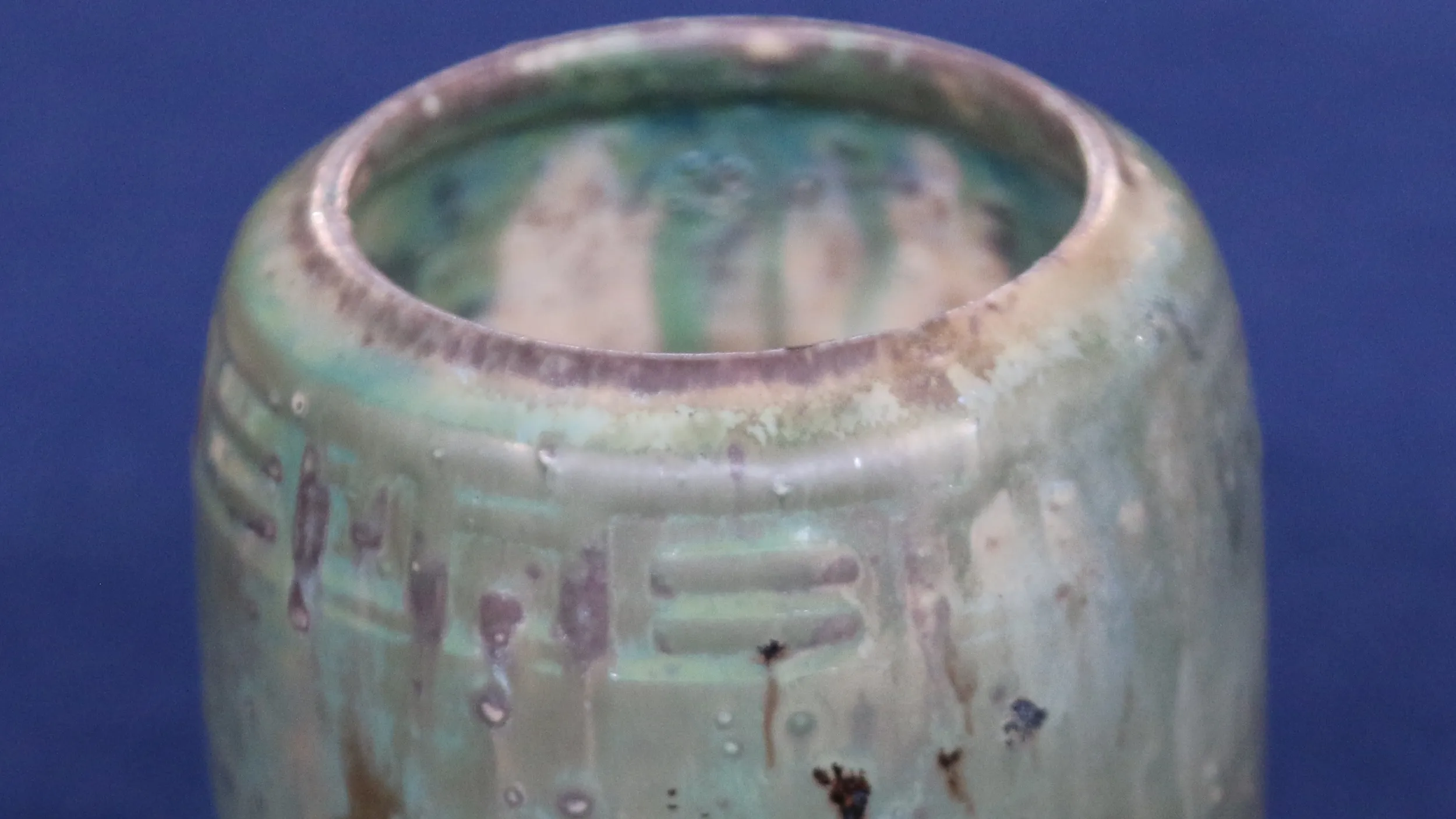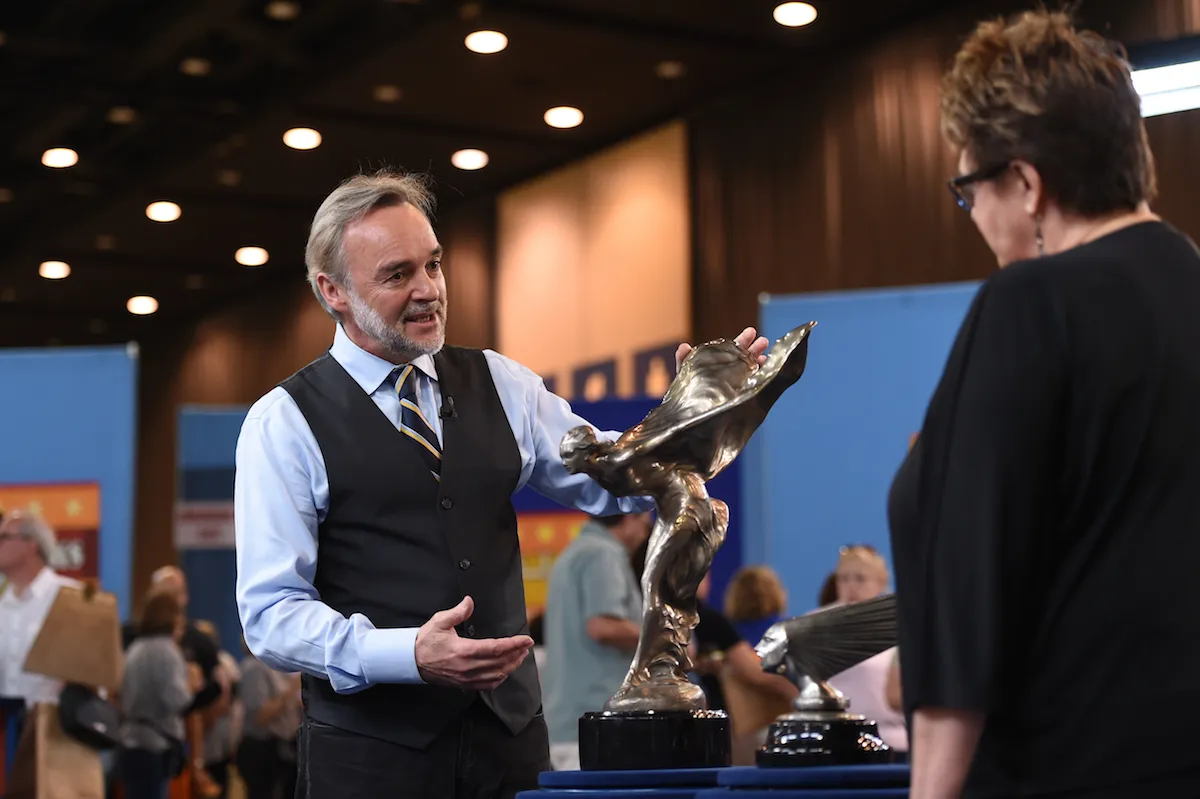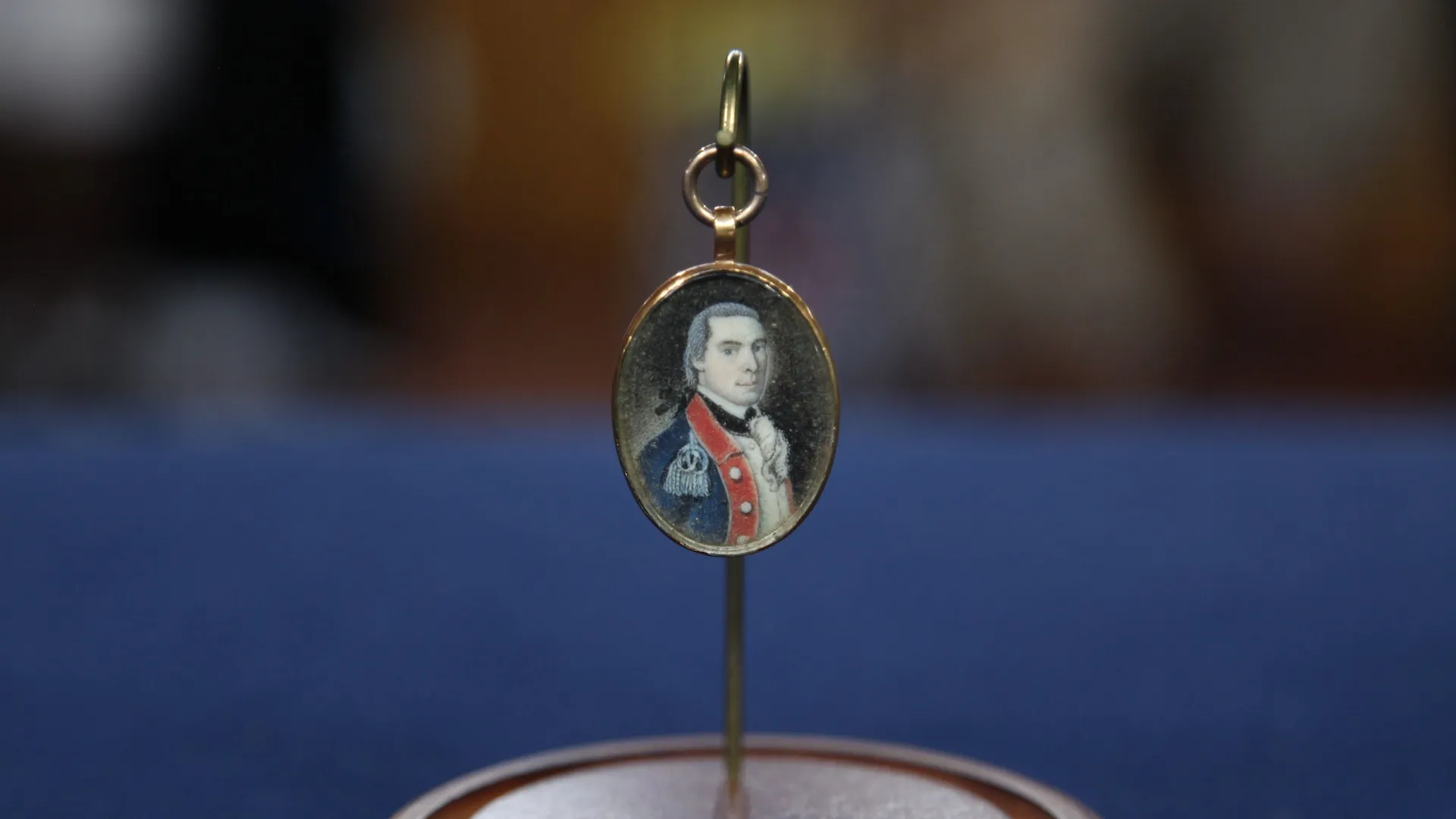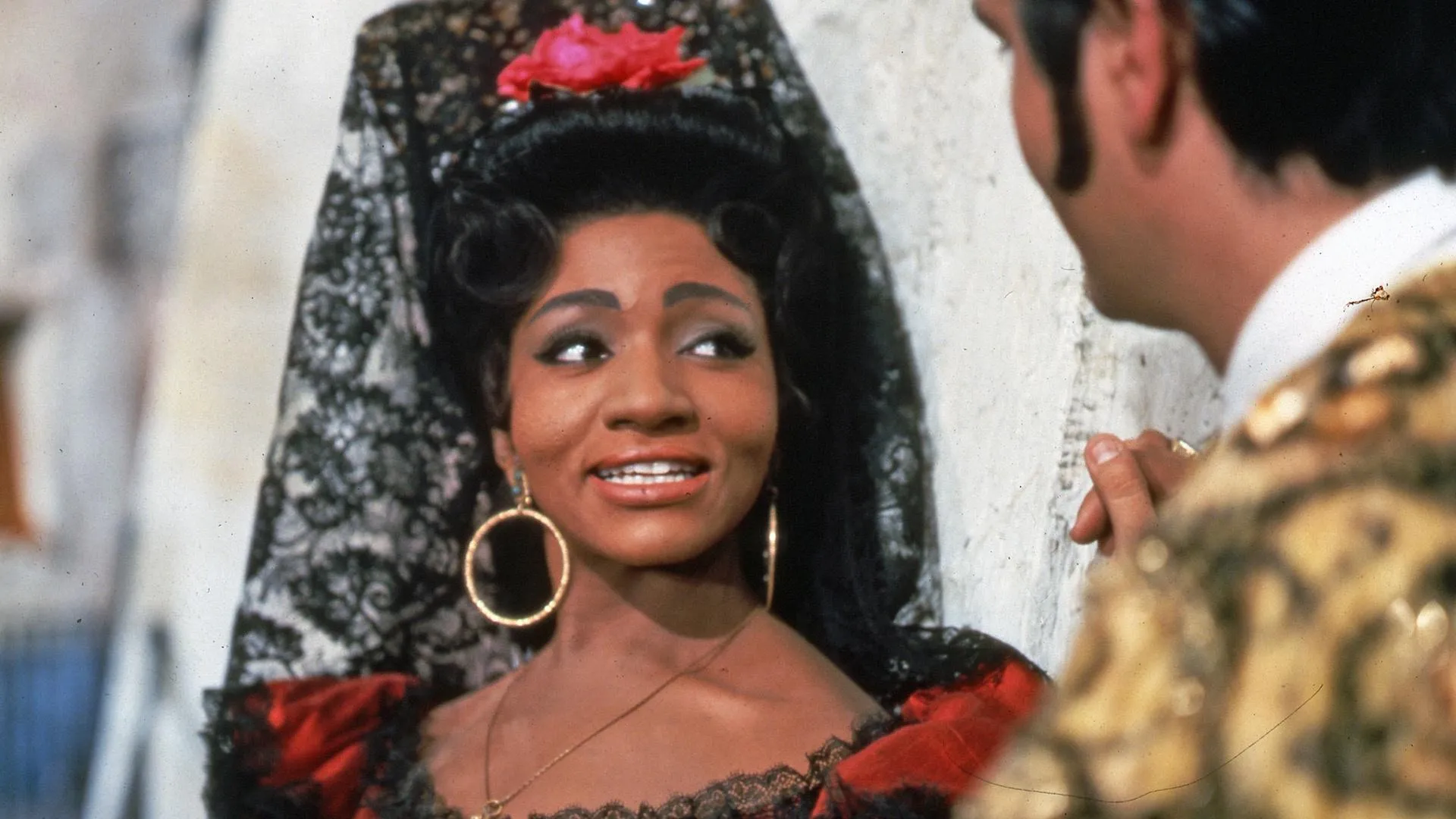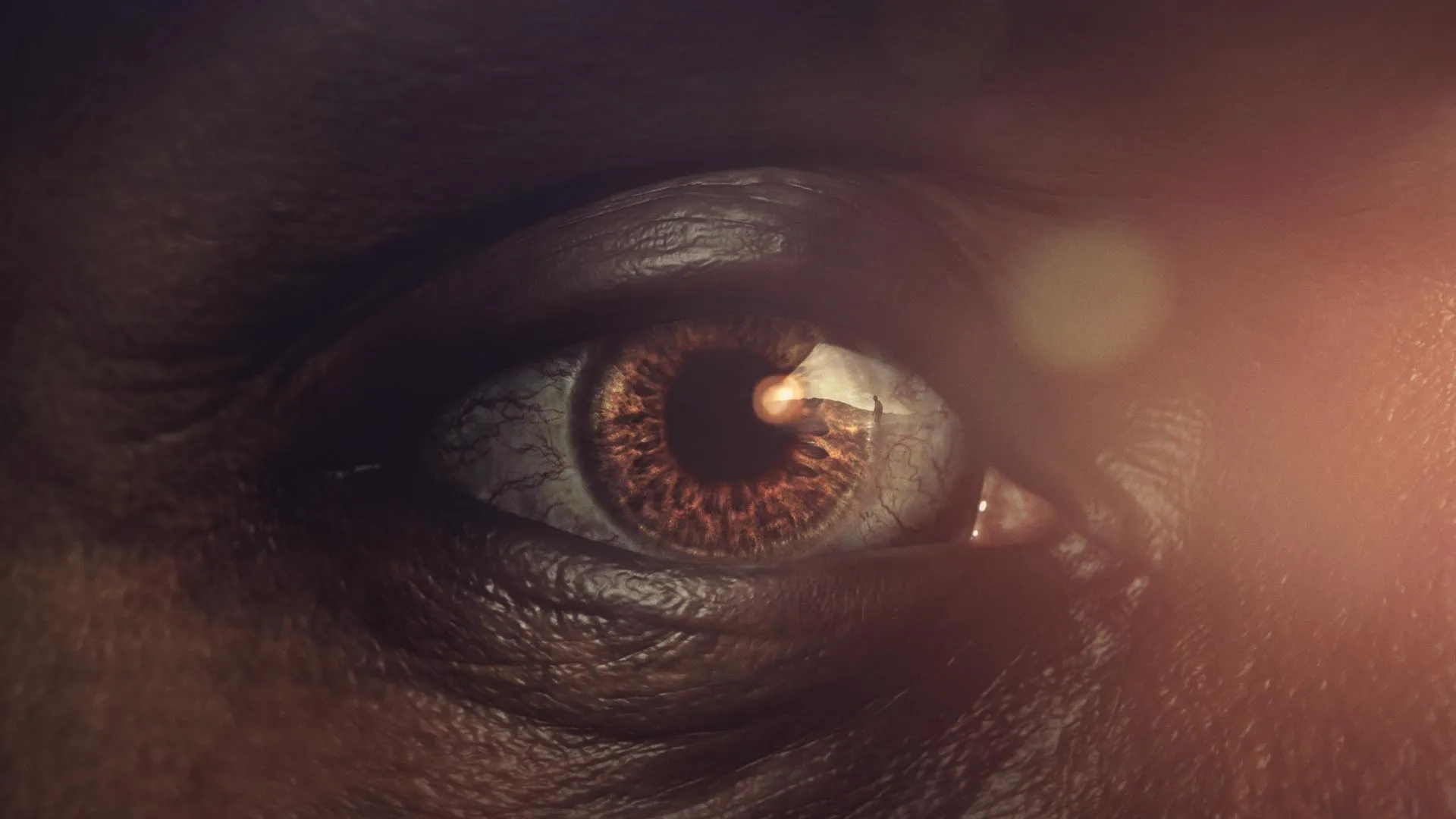MARK WALBERG: Antiques Roadshow was excited to pass through this gateway to the west-- Omaha, Nebraska.
GUEST: That's a lot for a little painting, isn't it?
GUEST: Holy Hannah!
GUEST: Wowser! Shut the front door, girl. Are you serious?
WALBERG: Founded in 1854, Omaha, now the largest city in the state of Nebraska, had another sold-out crowd, and big love for Antiques Roadshow.
ALL: Welcome to Omaha!
(applause)
WALBERG: One big find in the Cornhusker state: this work of art by a famous Midwestern artist, Grant Wood.
GUEST: My older sister gave it to me several years ago, and it's a Grant Wood lithograph, I think. I don't see any numbers on it. And I think she purchased it in Iowa City when she was doing graduate studies there many years ago.
APPRAISER: While he was there?
GUEST: He was... yes, he was teaching there.
APPRAISER: It is indeed a Grant Wood, it's a lithograph by Grant Wood, probably better known to most people as the painter of the famous painting American Gothic.
GUEST: Exactly.
APPRAISER: An iconic American image. But Grand Wood also made 20 different lithographs, different lithographic subjects. And this is one of them, in fact, one of his more popular lithographs, I believe one of his more popular lithographs because the scenery resembles American Gothic.
GUEST: Yes, it does.
APPRAISER: The lithograph was published by a firm out of New York, Associated American Artists, who during the 1930s through the 1960s were issuing prints by artists, some better known than others, to be sold inexpensively so people could own original art for fairly modest sums.
GUEST: Mm-hmm.
APPRASIER: This is, like the other lithographs that Grant Wood made under the auspices of Associated American Artists, one of an edition of 250. But none of them were numbered. And unlike his contemporaries-- Thomas Hart Benton, John Steuart Curry, the other regionalists-- Wood only made 20 different lithographs, whereas those other artists made a couple hundred each. So they're much more common. This is a lithograph entitled Fertility. He made it in 1939.
GUEST: Mm-hmm.
APPRAISER: It's in the original mat. You can see on the edge of the mat, there's some brown on the mat cut. That probably translates to some mat stain just beneath the mat, which is not going to be very detrimental to the value of the print.
GUEST: Mm-hmm.
APPRAISER: A fair replacement value on this, or an insurance value, would be in the neighborhood of $10,000 to $12,000.
GUEST: Oh, my.
APPRAISER: So...
GUEST: I'm very surprised.
GUEST: My husband and I were in the liquor business many years ago, and one of his customers came in one day and said that her uncle had passed away, and he was an MD, and that he had liquor at an estate sale that was from Prohibition. So I went over, and among other things, purchased this liquor. And for years, it has been put away, and it's never been opened.
APPRAISER: How many bottles did you buy at the estate sale?
GUEST: At the time, I think I had about 18.
APPRAISER: Wow.
GUEST: Yes.
APPRAISER: And do you still have the others as well?
GUEST: I do, I do.
APPRAISER: Wow, and are they all different brands, as these are here?
GUEST: Um… The ones I have now are the same brands. I just brought… I brought you one of each.
APPRAISER: And how much did you pay for these?
GUEST: I don't recall exactly, but it couldn't have been more than maybe $10 or $20 for all of them.
APPRAISER: What a great find. I mean, I'd be thrilled if I went to an estate sale and I ran into these.
GUEST: Well, this was probably…
APPRAISER: Right.
GUEST: …at least 35 years ago.
APPRAISER: We all know about the Prohibition. It was a long dry spell for America.
GUEST: Right.
APPRAISER: It went from the year 1920 to 1933. And there were a few select makers that were allowed to continue the production of liquor throughout…
GUEST: Oh, I didn’t know that.
APPRAISER: …Prohibition. And first of all, you have the words "Bottled in Bond," which means that they were bottled according to the U.S. government standards. But then also on some of these, you see where they're made for medicinal use, it says.
GUEST: Right, yeah.
APPRAISER: And so in the Prohibition era, you could go in to your physician, and it usually cost you about three dollars. You could have bronchitis, or you could say you had bronchitis. Right here, we have the Tom Hardy Whiskey Company. Here, we have the Frankfort Distillery. Over here, you have the Old Thompson, bottled in bond by the H. Barton Company. And then on the end, we have the special Old Reserve. That's got to be the good stuff there, huh? And then back here, this wonderful red and green, which is from Old Taylor, which is a real renowned old brand that went back into the 19th century. This one, for instance, has the original label on it. It says 1917 is when it was made, and then 1933 is when it was bottled. It has evaporated a little bit. Um --
GUEST: Right, I noticed that.
APPRAISER: Yeah, and what it is is there's not a super-tight seal on the cap. You know, there may be some cork in there, but over the years, there's evaporation. These are very, very rare. I've been in the business—
GUEST: Really.
APPRAISER: -- since I was 11, and I've never seen any. And recently, there was a write-up on some bottles which sold at auction which had all this Prohibition "for medicinal use" on them. Initially, I was thinking a lower value, but in talking to experts who have read some of these reports that have come out in the market lately, I believe a retail value on them would be $3,000 to $4,000 in today's market.
GUEST: For the five of them?
APPRAISER: For the five, and you have 18?
GUEST: Yeah.
APPRAISER: Wow.
GUEST: I am very, very surprised.
(both laughing)
GUEST: And pleased-- thank you.
VOICE: What did you bring today?
GUEST: It's a... uh… I was trying to find out what it is for sure. Uh, we got it at a swap meet, didn't we?
GUEST 2: I got it out of a barn.
APPRAISER: The reason that these are called pressed-back chairs is that it’s not... You know, it looks carved, right? They would take huge machines that you'd press in a mold, like you'd mold anything.
GUEST: We believe it's an advertisement for a streetcar. 1940s, '50s.
GUEST: Well, my great-grandfather worked on the railroad for Union Pacific for over 30 years. And he and my great-grandmother started collecting these timetables from all over the United States, and I ended up with them.
APPRAISER: So he was a real railway man.
GUEST: Yes, he was.
APPRAISER: These are timetables from the 1880s,
GUEST: Uh-huh.
APPRAISER: … and as you can see just from some of the names, there were a lot of small railway companies who didn't last.
GUEST: Uh-huh.
APPRAISER: They were sort of drops in the big railway bucket that eventually consolidated into what's now Amtrak.
GUEST: Uh-huh.
APPRAISER: And collectors really like these. They have this great graphic element on the covers of all of them.
GUEST: Mm-hmm.
APPRAISER: The one closest to you on the bottom is from Florida, uh, from 1884, and it has great pictures of palm trees. It was early in the days of American tourism, so there's a lot to be gleaned about our society and our culture from these. People also like them because of the maps inside. In my experience at auction, these things would sell for between $200 and $500 each.
GUEST: Oh!
APPRAISER: Now, you have 11 of them here, so that's roughly $2,200 to $5,500 for the group. And I know you have some others, but these are really the ones in the best condition, which I think were the best representatives of those prices.
GUEST: Would you repeat that?
APPRAISER: I would repeat that. Between $200 and $500 each for a total here, of just what we're looking at, of $2,200 to $5,500.
GUEST: Oh, my goodness. Okay, very good. Thank you.
GUEST: This is a painting by Henry Sharp that's been in our family for as long as I can remember. My great-uncle had a trading post, or was part of a trading post, in Montana. The trading post sat close to the cabin that Henry Sharp built there in about 1905. And my understanding is that he was friends with the owners of the trading post, and that's how they met and how the painting came to our family.
APPRAISER: Do you like the painting?
GUEST: I love the painting. (laughs) Because it makes me think of a lot of people that I love.
APPRAISER: Right, well I can understand that. It's been in the family for some time.
APPRAISER: Yes.
GUEST: The painting is, as you say, by Joseph Henry Sharp, who was born in 1859, lived to 1953. And it's clearly signed here on the bottom. The "J.H. Sharp" in block letters is very consistent with his signature. However, it's not dated. Many of the paintings where you have this sort of horizontal vista were done in the first quarter of the 20th century. Sharp was considered the founding member of the Taos Society of Artists. It's a lovely little painting.
GUEST: Yes.
APPRAISER: It's an oil on a cigar box top. And I love the painting for its detail. I love the fact that you've got the Indian encampments dotting the horizon line here, and we have the teepees here. And the painting is in unrestored original condition, which is great. It's a little hard in this painting to tell precisely the location. But I love the fact that the painting is really kind of like a little jewel.
GUEST: Mm-hmm.
APPRAISER: Your Sharp painting, if offered at auction, would sell between $12,000 to $18,000.
GUEST: Oh. That's... (laughs) that's a lot for a little painting, isn't it? I know my mom, who just passed away, would be thrilled.
GUEST: I brought in my grandfather's violin. My mom and dad always called him Pops. He died in 1945, so I never got to meet him. But he made violins, and he repaired violins for the Philharmonic, the Boston Pops, the New York Symphony. He worked for a company for a while, and then he opened up his own shop. And when he passed away, my mother took one of his violins, and I played this violin since I was in second grade until I had an injury and could play no more. And I am dying to find out what to insure it for. I… I've heard the story of my Pop for all of my life, what an amazing man he was, and everything he'd done, and how he became a violin maker.
APPRAISER: Well, I'm very excited about this violin that you brought in today. You brought in his tools, and you brought in a picture of his shop in Manhattan.
GUEST: Yes.
APPRAISER: His name, of course, was Nicholas Heinz. He started training as a violin maker when he was 14 years old. So he studied with Frederick Koenig, who was a violin maker in New York City. And so your grandfather, from the age of 14 to 19 years old, trained with one of the top makers in the United States. He also worked in Chicago for Lyon and Healy. He worked in Philadelphia. And then he opened his own shop in 1926. So this particular violin that you brought in today has a label on the inside, and it says, "Nicholas Heinz, Violin Maker and Repairer." And above that label is a brand that's been branded into the wood that says, "N. Heinz." I love this picture. He seems so proud, and just brimming full of energy. These are his knives for carving,
GUEST: Correct.
APPRAISER: …and this little tiny plane is a violin maker's plane. It's used to do the arching, the fine arching that would be around the edges of the instrument. This violin is made in very traditional materials. The belly of the instrument is spruce, and the back and the ribs are a flamed maple.
GUEST: Ah-ha!
APPRAISER: And the pegs are carved in a beautiful design, as is the tailpiece. I believe that the pegs and the tailpiece were actually made in Germany, and that he would have purchased them
GUEST: Oh.
APPRAISER: …for this instrument.
GUEST: I thought he made them.
APPRAISER: What do you know about the bow?
GUEST: I know how I broke the tip on the bow, but I don't know much about the bow. I fell off the stage playing the violin when I was a young girl, because the girl next to me kept butting me with her arm on the violin, and I scooted my chair over and I fell off the stage.
APPRAISER: Oh, dear.
GUEST: On the way down, I thought, "Well, I can drop the bow, but I can't drop the violin—my mom will shoot me." And when they called to say that I'd fallen off the stage, my mother goes, "And how's my violin? Did she break it?" And they go, "No, and Irene's okay, too."
APPRAISER: The tip plate broke off, but it doesn't affect the value. And the tip plate is perhaps ivory. It's either ivory or it's mammoth, but you can't tell by just looking at it. And that can be replaced, it's not a big deal. So the bow is intact, and the bow is a French bow. It is stamped right here. It's stamped "Paris." So in the world of retail, I would value this bow at $4,000.
GUEST: Holy Hannah! Wowser. Shut the front door, girl. Are you serious?
APPRAISER: Yeah, it's a beautiful bow.
GUEST: Wow, wonderful.
APPRAISER: The violin I would value...
GUEST: My baby.
APPRAISER: ...at $12,000.
GUEST: (gasps)
APPRAISER: It's a master quality instrument.
GUEST: Oh, sweetie, I love that.
APPRAISER: And all of the ephemera that you brought, the tools and the pictures and the letters, I would say combined with the value would add $3,000 to its value.
GUEST: Oh, my goodness.
APPRAISER: So all the ephemera and the violin should always stay together.
GUEST: Well, it belonged to my grandmother. And when we were little, I remember, you know, thumbing through it. Never really got too much into it. And when she passed away, my mother got it, and then before she died, she was telling us everything not to, you know, put in garage sales and such, and to hold on to it. So when I had the opportunity to come here, I went through the box and was looking for neat stuff.
APPRAISER: Well, I'd say you picked pretty good. What did your mom tell you about it other than you shouldn't put it in a yard sale?
GUEST: Not much. I mean, she said they were scissor clippings, and that's all I know, and I think she said from the 1800s.
APPRAISER: And you don't know where she got it from or your grandmother got it from?
GUEST: No, I don't.
APPRAISER: Okay. When I first opened this up and started looking at it, it kind of blew my mind, because you don't normally see so many pages executed in something like this. This is a schoolgirl's cutwork album, and they would have gone and taken classes to do it. And some could do better than others, and I think this young lady was basically a master at this. But the first thing I wanted to figure out was whether it was American or English. I decided that it probably is English, because there's quite a few images of churches and different buildings that are in England. But the one thing you've got to remember is when they were doing this, a lot of these images were print-inspired. But the good thing about what she did was she took this and she used her imagination. And the best ones of these are always going to have some watercolor and pencil drawings and things. The reason I wanted to show this page, because right over here, it says, "Merchant of Hudson Bay." Over here, it's almost like scenes in a play or something. She had scenes that had animals. And the reason I like this one over here was because it shows interior scenes-- like, there's somebody sitting at a tea table in what looks to be a Pilgrim Century or a William and Mary style chair. And look at this kitchen with the mother at the table, the bird in the cage. It's got the cat. And there's over 60 pages in here. And being conservative, with 60 pages, at $300 a page, we feel like that an insurance value for this would be around $18,000.
GUEST: Wow. That's good.
APPRAISER: You're a lucky man. You know, all I got from my Grandma was, uh, dishes.
(Both laugh)
VOICE: What are you bringing in today?
GUEST: A painting. Uh, not sure, not sure. It's not signed. We think it's Fritz Scholder…
VOLUNTEER: This is a real antique. I painted that.
VOLUNTEER: Yeah.
APPRAISER: Walt, you're working on the floor today, right?
VOLUNTEER: Yes, I am.
APPRAISER: And what happened? You see this painting walking in...
VOLUNTEER: I saw that walk in, I haven't seen it for several years, but I did that painting.
APPRAISER: I'm sorry that it ended up in the thrift shop, but I'm thrilled that it ended up here.
VOLUNTEER: Well, I am, too.
APPRAISER: And with the artist here, I can only say that the painting is priceless, right?
VOLUNTEER: Good answer.
(Both laughing)
GUEST: Well, this is a banner that I inherited from my grandfather. Uh, he got it in the mid 1930s. It's an Olympics banner from, uh, I believe the 1932 L.A. Olympics. Uh… and that's really about all I know about it.
APPRAISER: And he did indeed find it in Los Angeles, correct?
GUEST: Yes, he went to school there briefly in the mid 1930s.
APPRAISER: Okay. And so for it to have surfaced in the L.A. area makes sense, following the Olympics of 1932.
GUEST: Yeah.
APPRAISER: It's a screen print on cloth. And we're also very impressed because we've never seen this one before. In fact, most of the items from the 1932 Olympics, except for tickets and stubs, are quite rare. It was an unusual Olympics, with the Great Depression going on. About half the athletes that participated in the 1928 Olympics couldn't make it to the 1932 Olympics. President Hoover didn't attend either. And probably because of the fact it was the Great Depression, there's just not a lot of pieces we see, especially pieces like this that most likely hung in the stadium. We see at the top, it has the grommets where it was most likely hung. Have you ever had this item appraised before?
GUEST: Uh, no, I never have.
APPRAISER: We have put a value at auction of $2,000 to $4,000.
GUEST: Terrific. That's excellent.
GUEST: When I was a little girl, my aunt gave that to me as a gift. And I've cherished it. I've never worn it, because it was so large and ornate. And it’s been tucked away in a jewelry box ever since.
APPRAISER: When did you receive it?
GUEST: Oh, gosh. In the '50s.
APPRAISER: Okay, all right. So since you got it in the '50s, it was probably new in the '50s.
GUEST: Yes.
APPRAISER: Because it was made by a company called Har, H-A-R. It was actually Hargo Creations of New York, and they were in business for a very short time. They started in the 1950s, and they went out of business in the 1960s. But they were known for exotic jewelry pieces that people really want to collect today because they had limited production.
GUEST: Mm-hmm.
APPRAISER: So what you brought me, it's from the Fantasy series. And this is called the Genie bracelet. And it's also got a Genie brooch. Now, we can call it a Genie because right here is a genie. And he's got a crystal ball, but it's not crystal. It's actually Lucite.
GUEST: Okay.
APPRAISER: We also have an image of the Taj Mahal, and we have Aladdin's lamp. And in the front position, we have a piece of glass. It's called Dragon's Breath. It has kind a red blue-green flash color. It's all costume jewelry. But the secret to the unusual quality of the Har pieces is they were multilayered. We've got red aurora borealis rhinestones. We've got crystal rhinestones. We've got another piece of Dragon's Breath glass in his turban. We've got some blue rhinestones. And it's a 3-D composition. Very hard to produce. So when a piece like this comes on the market a lot of people would like it. Do you wear it?
GUEST: Actually, it was so large, and I was afraid to hurt – to do anything to it. You know, I didn't want it to break or anything. I'm a keeper, and I like to keep things nice, and so it's been in my jewelry box. I've taken it out many times and looked at it, but I've never worn it.
APPRAISER: Have you ever wondered what it might be worth?
GUEST: Oh, yes, oh, yes.
APPRAISER: Oh, yes.
GUEST: Now I really wonder!
APPRAISER: Well, due to the popularity of it, the fact that collectors really want this genie bracelet, a good retail location, this bracelet would sell for $1,200.
GUEST: My word. That blows me away.
APPRAISER: And the brooch would be in about the $100 range.
GUEST: Oh, my. That's amazing. I had no idea. I just kept it because I thought it was so unique.
GUEST: This was actually a gift when I got my first apartment in San Francisco, which was quite an achievement. I had roommates forever, but my first real apartment on my own was special, so my mom gifted this to me for housewarming. It was something I was always attracted to, different than any other knickknack in our house growing up.
APPRAISER: Well, how did your family end up with it?
GUESt: My great-great-uncle Hadi was an artist in Syracuse, New York. I don't know if he dug it out of the garbage in Syracuse or if it was gifted to him, if he was friends with the artist. Somehow, Uncle Hadi ended up with it. Uncle Hadi was very close with my grandfather.
APPRAISER: Mm-hmm.
GUEST: My grandfather gave it to my mother, and my mother gave it to me.
APPRAISER: This is a piece of pottery by Adelaide Alsop Robineau. And arguably, there are two great potters from the early 20th century in America: George Ohr, who was on one end of the spectrum…
GUEST: Mm-hmm.
APPRAISER: …crazy guy with a big moustache making 10,000 pots out of local mud; and diametrically opposed was Adelaide Robineau, working not with mud but with porcelain. A refined woman from Syracuse, a woman of social stature, who made 600 pieces, they say, in her entire career.
GUEST: Wow.
APPRAISER: If she wasn't completely happy, she would destroy a piece.
GUEST: Mm-hmm.
APPRAISER: Ohr never destroyed pieces. When his pottery burnt down in the Great Biloxi Fire, he saved the burned pots. He called them his burnt babies. So…
GUEST: Oh, you're kidding.
APPRAISER: You could not have had two personalities as different as George Ohr and Adelaide Robineau.—
GUEST: Yeah.
APPRAISER: -- yet in their way, they made the best pottery in America, at least for the first half of the 20th century.
GUEST: That's fascinating.
APPRAISER: This is a pretty good pot. It's not a great piece of Robineau, and I'll tell you why it's good and how it could be better. This piece is hand thrown. If you look on the inside, you see the… the turning rings. And also, if you notice around the top, this has hand tooling going on, a three- or four-glaze flambe. It's also very nicely signed by Adelaide Robineau. And what I also found here, there are these little tiny checkmarks. I think those are experimental marks, notes that she made on the piece so she understood what glazes she was playing around with.
GUEST: Okay.
APPRAISER: Because this was so experimental, she tended to date her pieces, and this one isn't dated. And because it's a little crude, my guess is it's an earlier example of her work…
GUEST: Mm-hmm.
APPRAISER: …so I would date this from about 1905, 1906.
GUEST: Okay. Do you think it was something that she threw in the garbage? I noticed it's crooked, I don't know if you saw. And there are a lot of bubbles and things in it.
APPRAISER: I don't think it's a second. My understanding of Robineau is when she had to second a piece, she destroyed it.
GUEST: Like shattered it.
APPRAISER: Yeah, shattered it. So that it survived means she must have thought it had something going on. It's a little uneven, it's a little lumpy, it's not a graceful form, but nevertheless, you have a piece, with some size, of porcelain, hand thrown—
GUEST: Mm-hmm.
APPRAISER: --hand carved by Adelaide Robineau in perfect original condition. Because it's not a great piece, at auction, I think the value would only be between $10,000 and $15,000. "Only."
GUEST: "Only."
APPRAISER: Which gives you an idea of how expensive Robineau can be, because, uh, there are pieces of Robineau that have brought six figures, and there are pieces, were they to come to market, would bring seven figures.
GUEST: Would that be something like her scarab vase that's in the museum, intricate carving...
APPRAISER: A masterpiece, really.
GUEST: Mm-hmm, masterpiece.
APPRAISER: And that would be certainly a seven-figure piece.
GUEST: I bought it at an estate sale.
APPRAISER: Recently, or...?
GUEST: About a year ago.
APPRAISER: Mm-hmm. And what did you pay for it at the time?
GUEST: About 12 dollars.
APPRAISER: Uh-huh. And what can you tell me about it?
GUEST: It's by a Mexican artist, I think. He had to go to France because he left Mexico because he made up a story about the army. He said that the army massacred, um… a small town. It was a lie, I guess, and so he had to leave Mexico, and he went to France, and he was influenced by Impressionist painters. And I think the last house he lived at is a museum in Mexico City.
APPRAISER: Yep, okay.
GUEST: That's about it.
APPRAISER: So the artist is Joaquin Clausell, who was, as you rightly pointed out, a Mexican artist. He was actually a lawyer by trade.
GUEST: Ah, yes.
APPRAISER: And was also a political rabble rouser, as you've rightly said.
GUEST: Yeah, I think they called him the Chicken Lawyer.
APPRAISER: Yep. He went to law school, but took rather a long time to finish because he kept getting in trouble with the government.
GUEST: Mm-hmm.
APPRAISER: He lived in Campeche and was not a fan of the governor, to say the least, and got jailed several times for being rather outspoken. Then had the little writing incident, was jailed for that. Just before his trial, he escaped and went to Paris, and that's where he saw the works of Sisley and Pissarro. And he'd never been a painter before, but he saw these amazing works and was just fascinated. When he came back to Mexico in 1903, he- that's when he began painting. So he came to painting... he was in his mid-30s when he started painting. It's a wonderful oil painting, probably done in the 1920s. How do you know who it's by? Because the picture isn't signed.
GUEST: Well, on the back, there's a label.
APPRAISER: Yeah, so let's take a look at that, because the label's rather interesting. So I'm just going to turn it around. If we can take a peek... So the label is extremely helpful. It gives us the title, "Pasaje del Estado de Mexico," and yes, I'm sorry, I just butchered the Spanish language. "Del studio de Joaquin Clausell," which means "of the studio of," and then gives the artist's dates. What's interesting about this label is it doesn't give us a full attribution.
GUEST: Mm-hmm.
APPRAISER: It relates it to the artist or his studio. So it's a telling label. The other thing that's interesting is -- and makes this a little bit of a conundrum -- is the picture's unsigned. He didn't sign all of his works. He was known to be rather sloppy about that. He was also sloppy in terms of materials. He would just grab whatever he could find. But because we can't be 1,000% certain in the context of being here that this is right, we have to consider it an attribution. Now, in doing so, we look at the picture and consider how strong a likelihood is it that the picture is what it purports to be. And I think the likelihood that it's right is extremely strong.
GUEST: Okay.
APPRAISER: But as it stands right now, we have to consider it a work that's attributed to.
GUEST: There's also some fingerprints on the back. You think this frame... he could have made this frame, too?
APPRAISER: I think the frame is probably not by him. And it - it's near period, but somebody's clearly repainted it.
GUEST: Okay.
APPRAISER: As an attributed picture, at auction, I would give it an estimate of $15,000 to $20,000.
GUEST: Okay.
APPRAISER: Having said that, the real next step is to do the research. And in order to do that, we would want to contact an expert on Clausell's work. Now, in 1995, there was a huge retrospective at the National Museum of Art in Mexico City, and the first thing we would want to do is contact the curator of that particular show. If we can establish beyond any doubt that it is indeed Clausell's work, then we would have to be more aggressive with the estimate. And at auction, if it's a full attribution, we would estimate it at $30,000 to $50,000.
GUEST: Very good.
APPRAISER: It's a great picture.
GUEST: Yes, I like it a lot.
APPRAISER: I think you made some good money.
GUEST: I think so.
APPRAISER: Well done.
GUEST: They're actually from, uh, Germany, ah, late 1800s. They were my mom's, and they were given to my mom by a major that was, uh, over in Germany after World War II.
(laughter)
GUEST: The people I bought it from said it had come from some prison. They didn't know which one, so...
GUEST: My husband gave this to me for Christmas, 1978. And he bought it as a Tiffany, and I was wonderfully happy until I started watching Roadshow, and this was not like any other Tiffany bowl. He went back to the same dealer that he bought it from, and she said, "If I said it's a Tiffany, it's a Tiffany." In 1999, we went to Roadshow in Des Moines, and I took the bowl. And they confirmed that it is a Tiffany, 1894-1895, and valued it at $2,500 to $4,000. Then when I decided to downsize, I took it back to the dealer that my husband bought it from, and she said, "That's not a Tiffany, and I never would have said it's a Tiffany." And I want to know, is it or isn't it?
APPRAISER: So that's why you're here today.
GUEST: That's why I'm here today.
APPRAISER: Well... It is.
(both laughing)
GUEST: Oh, I'm so glad, because she said, "Well, that just shows you that those people on Roadshow don't know what they're talking about."
APPRAISER: Ah, but we do.
GUEST: You do.
APPRAISER: And something very near and dear to my heart is Tiffany.
GUEST: Oh!
APPRAISER: And you're right, and we must have told you back then that it was made around 1894, 1895. And this coloration, you don't see this after 1900. And actually, it's very prized by collectors. And it's a little esoteric, and yes, it doesn't look like the blue and the gold iridescent that is so recognizable, or the paperweight vases, or the jack in the pulpits, but this is very special. And they made it for a very short period of time. So I'm really happy you brought it back to us so we could tell you again. And, um… in today's market, it's gone up since the last time you were here. It's now worth $4,000 to $5,000 in a retail shop.
GUEST: Wonderful, thank you.
APPRAISER: You're very welcome.
GUEST: Thank you.
APPRAISER: My pleasure.
GUEST: Can I hug you?
APPRAISER: Of course!
GUEST: I acquired this from a very dear friend of mine after her father's estate sale. It didn't sell at the estate sale, and she offered it to me.
APPRAISER: And how long have you had it?
GUEST: 26 years.
APPRAISER: And what did you pay for it at the estate sale?
GUEST: I paid $100 for this.
APPRAISER: You've brought in a set by Charles and Ray Eames, the famous married design duo that was very prolific. There's a few reasons for their success. One is they were very inventive in their use of materials. They were known for their connections and how they brought materials together. And in this case, we have what's known as the aluminum group chair set and a dinette table. The chair set was designed originally as outdoor furniture, but it became extremely popular. And because it's lightweight and very functional, people started using it for their patio sets, dinette sets, and even in their formal dining room. And in fact, I have a very similar set in my dining room. It was first designed in 1958, and it's still in production today. This set I believe was probably made in the late '60s or early '70s, because of this color vinyl.
GUEST: Okay.
APPRAISER: Being from Los Angeles, I would describe this color as Dodger blue. They were available in brown and black and tan, but I think there's something about this particular shade of blue that expresses the optimism of that postwar American period. Just bright and optimistic and colorful. And interestingly, the vinyl has really held up over all these years. Each of these chairs has a molded stamp in the aluminum underneath that says, "Herman Miller," which is good because that tells us it's authentic. But it also gives us a little bit of a clue as to when it was made, because that stamp changed slightly over the years.
GUEST: Okay.
APPRASIER: In the late '60s and early '70s, this was what the stamp looked like. The table actually has a little medallion underneath that says, "Designed by Charles Eames." And if you look at this example, there's a paper upholstery label here with an address in Los Angeles. This dates it from that late '60s, early '70s period as well. If it didn't have the label and it didn't have the stamp, we could still tell by the quality of the vinyl and the patina on the aluminum. This set has been in continuous production since it was designed in 1958, so that means there's a lot of them out there. So when you have that many pieces out there, you would expect these things wouldn't be tremendously valuable because they're still making them today. Interestingly, each one of these chairs sells for about $1,300 new.
GUEST: Wow.
APPRASIER: So if you went to Herman Miller today, this set would cost you quite a bit to buy brand new. What do you think would be the case, if these are worth $1,300, how much would an older vintage one be worth? Is it worth less than what a new one is worth, or is it worth more because it's vintage and more collectible?
GUEST: You know, I'm going to say maybe more.
APPRASIER: In this case, it's worth a little less.
GUEST: Okay.
APPRAISER: The marketplace being as it is, and because there's so many examples out there, this set would probably bring between $3,000 and $4,000 at auction. Collectors are just starting to realize that the older ones are probably a little bit more desirable and a little bit better, and I expect that to go up. I can't believe that a good old survivor like this is worth less than the cost of one new today.
GUEST: This was brought back to the United States by my grandfather after he had been discharged from World War I. This is a picture of him and the ace that had crashed the airplane. And the ace gave my grandfather, who was the mechanic on the airplane, the insignia off of the airplane. I don't know what has happened to the rest of it. We think that Grandfather had to cut off some of it in order to get it in his duffel bag. And this is a picture of my grandfather.
APPRAISER: You know, looking at the image, I think we are most likely seeing that there were two of these, one on either side of their aircraft. And the one in the photograph is the one from the other side. So certainly once an airplane like this cracks up, they generally... if they can fix it, and they may not be able to, they certainly are going to re-skin it. And when I say re-skin, that's an important thing to remember about First World War aircraft, is that they were made out of wood.
GUEST: Yes.
APPRAISER: It's a wooden airplane, generally a spruce frame that's covered with what they call a doped fabric, meaning that it's painted with something that makes it very taut and resistant to dings and scratches and...
GUEST: Elements.
APPRAISER: Resistant to the elements to a degree. They weren't so bullet resistant.
GUEST: No, they wasn't, and that's how this came to be crashed.
APPRAISER: The point of it, though, of having aircraft designed that way, is because it made them extremely lightweight, so it doesn't require a whole lot of horsepower to get them off the ground. And they really didn't have a whole lot of horsepower at their disposal. Looking at the material, we can tell that the aircraft was being flown by somebody in the 258th Aerosquadron, and they got involved pretty late in the war. Like so many American squadrons, they went over and then spent a lot of time waiting for aircraft to arrive. What they were flying were Samson IIs, which was an observation aircraft. Not a lot of aces in observation aircraft. They weren't involved, really, in air-to-air combat. In fact, this particular squadron saw a lot of antiaircraft fire, but as far as the records that I was able to find, didn't get involved in any aircraft-to-aircraft conflicts. So it may be that the gentleman was from another squadron, but that really doesn't affect the value of the piece.
GUEST: Okay.
APPRAISER: We have wonderful documentation, great provenance from your grandfather. We can see the aircraft that's crashed, we can see where they have cut the piece off the side. It's a premium piece. Collectors are very, very interested in aircraft art from the First World War. If you were to insure this today, you would need to put an insurance value on this item for $10,000 to $12,000.
GUEST: Okay. Wow. We'll never sell it. It'll never be for sale, ever.
GUEST: So why is it marquetry and not parquetry?
APPRAISER: Marquetry is figural, and with curves and lines. Parquetry is geometric. Fabulous example of French Art Nouveau. Put an insurance value of about $20,000 or $25,000 on it.
GUEST: And I don't know how old it is, but I bought it in Scottsdale, Arizona, 27 years ago. And I just love it, and it sits out on my kitchen counter.
GUEST: Ah, when I bought it, it was at a Methodist church in Sterling, Nebraska. It's a Grand Army of the Republic window. It's the Sons of the Civil War.
GUEST: We were at a garage sale, and I happened to see them in a tub, and went, "Oh, my, it's an oyster plate," and found five more of these, and found six of the ones on the end, all for a dollar apiece.
APPRAISER: A dollar apiece.
GUEST: Yes.
APPRASIER: Not bad. And so that was okay with you, a dollar apiece?
GUEST: That was very okay with me, so...
APPRAISER: I bet, sure. We have a variety made by George Jones in England, and this one, which is a little bit more generic.
GUEST: Yes.
APPRAISER: The marketplace varies tremendously. The majolica market has softened considerably over the last several years…
GUEST: Okay.
APPRAISER: …but the oyster plate market has not.
GUEST: Ah, that's good.
APPRASISER: The oyster plate market is doing phenomenally well. And ideally, the more color, the more pop that the colors have, the more valuable. This one, very generic. In today's market here, you can pick these up for between $50 and $100 apiece.
GUEST: Oh my, okay.
APPRAISER: So you get your one dollar investment back.
GUEST: That's not bad.
APPRAISER: On this one here. But now we have three George Jones ones, and we know that by the mark on the back. They have what we call a thumbprint mark that's totally distinctive of being George Jones.
GUEST: Okay.
APPRAISER: These would date to about 1875.
GUEST: Really?
APPRAISER: In theory, this one would sell about $400 to $600.
GUEST: Each?
APPRAISER: Yes.
GUEST: I have three of those.
APPRAISER: And these two, each, more like $600 to $800.
GUEST: I did very well.
APPRASIER: Each. For your one dollar, one dollar, one dollar... you paid one dollar each for them?
GUEST: I did.
APPRAISER: Okay.
GUEST: Wow.
APPRAISER: So that's not such a bad thing.
GUEST: That's a very good thing.
GUEST: I brought an icon that I received from my father. My father got it from my uncle, who was an art dealer and collector. He passed away about 15 years ago. When he passed away, my mother was offered this icon. She was really attracted to it. She was a very religious woman. She passed away about a year ago, and my father I don't think really had that much interest in it, so he offered it to me. Other than that, I don't know anything about it.
APPRAISER: Okay. This one is a quite nice icon as far as its oklad. The oklad is the cover on the icon itself. It's the silver cover. What it depicts is Christ the Almighty or Christ Pantocrator, which is a favorite subject of Russian icons. In the left hand of Christ, he's holding the New Testament. In his right hand, he's holding up his fingers in a blessing or teaching pose. That's the typical way that Christ Pantocrator is shown. It's basically Christ being the Omnipotent. In Russian icons, the same subjects appear over and over again, and certain poses are referred to as the name of that icon. It's also written down here in enamel-- (speaking Russian)-- in Russian. So that's also, in Russian, Christ the Almighty, the Omnipotent, the All Holder. What I can also tell you about this is that it's very beautifully chased and repoussé silver. And by that, I mean if you look around the borders, the silverwork, where it's very finely done, it's chased with instruments to make impressions into it. And at the same time, you have a repoussé, which is silver hammered from the back, which is in his vestments, for example. And you also have other types of actual Russian craftsmanship that people were celebrated for, including champlevé and cloisonné enamel. Now, this is an example of the cloisonné enamel. This is where the enamel was poured into, like, a kind of a filigree-type surrounding. And then you have champlevé. That is where it's kind of flat. It's within the same plane. So you have a bunch of different styles of enamel, silver and enamel workmanship here. Do you know what time period it's from?
GUEST: I don't have any idea.
APPRAISER: Well, actually, this is fairly easy to date, at least the oklad-- again, the oklad being the cover-- because there is a date. It's actually on the bottom, right next to the hallmark. And it has an "84," which is referring to the silver purity. It's the Russian silver purity mark. And they would have an assayer's mark, which it does, and an assayer's date, which it does as well, of 1892. So that's how we can know it is from 1892.
GUEST: Okay.
APPRAISER: At least the oklad. Now, it could be that the icon itself is from a different date. But the value of this is actually going to be more in the oklad. Do you have any idea of its value?
GUEST: None whatsoever.
APPRAISER: If you had to guess, what would you think?
GUEST: A few thousand.
APPRAISER: Okay. Well, I can tell you that these are very popular now amongst Russian collectors. In a retail environment, this would be about $20,000.
GUEST: Oh my gosh. That's amazing.
APPRAISER: And I should say that that is also considering that, if you notice down here, it's missing one of the appliqués.
GUEST: Yeah, and that actually... I know when my mother got this from my aunt, it was there, because I have a photograph and I know it was there. And my father said it fell off at some point, and it's somewhere. So I think we have it, I just haven't found it.
APPRAISER: Okay, fantastic. If you can find it, that would be excellent. It is something that could be restored, it is something that could be remade, and that would bring up the value a little bit higher as well. It could be closer to $25,000 or $30,000.
GUEST: Oh my gosh, that's amazing. That is so cool.
GUEST: This bowl has been in my family since I can remember. I believe it belonged to my great-great-grandfather and great-great-grandmother. They were born in Ontario and came down from Ontario into Iowa, and then into Nebraska. And I believe this came on the wagon train with them. They kneaded bread in it, and they bathed the babies in it, and they used it for most everything. Its job today is to sit on my dining room table with silk flowers in it.
APPRAISER: Okay, well, I'm really glad you brought this bowl in. My brother and I, my twin brother and I, collected burl bowls, which is what this is, is burl wood. And this is made of ash. And the burl wood is tightly grained. And you can see those knots in there, which we can see, almost like a bird's eye, we call it, design. And it's intertwined, so it's almost impossible to damage. And even these chips here are natural.
GUEST: Oh, are they?
APPRAISER: And they left these, by the way, these imperfections, on purpose. This bowl was made by the Woodland Indian tribes.
GUEST: Oh...
APPRAISER: Which stretched from the Atlantic all the way to the Great Lakes. To the Native Americans, bowls like these, and the burls in a tree, were kind of a symbol, as these vessels are, of fertility. And so they had a sacred meaning to the Native Americans. But this bowl, based on the wear patterns and the shape and the fact that it's made by the Native Americans, not the colonists, who would have turned it on a lathe. This was actually hand scraped. First, they would put them in the fire and burn the inside, let that cool, scrape the charcoal, and do it over and over. And this is around 1780, 1800, this bowl. The great thing about your bowl is this red pigment on here is usually gone, because it gets refinished. This would have been originally all red. Bowls like these are really prized. I would put an auction estimate on this bowl at $8,000...
GUEST: Oh, my.
APPRAISER: ...to $12,000.
GUEST: That's wonderful.
APPRAISER: So you have quite a bowl here.
GUEST: We really do, we really do. And I knew it was special, but I didn't know it was worth money as well.
GUEST: Today, I brought a Rolex watch that I purchased in 1973. And I purchased the watch because I was flying. I was a private pilot. I've been a private pilot since I was 20 years old. And what I was doing, I was finding sites for a national restaurant chain in South Dakota and Nebraska. I bought the watch hoping it would help with navigation, basically, because you can check a measured mile by the number of seconds it takes to go across the measured miles, and it gives you your ground speed, so it helps you with your navigation, so to speak.
APPRAISER: What you brought here today is a Rolex Daytona, and it's a triple register chronograph. Three register. Here's the buttons for functioning. And this particular one is in a solid gold case with the black enamel bezel. And these watches were mainly used by people such as yourself: pilots, racecar drivers, anything to do with timing, functioning, such as you did with the land survey. This particular model of Rolex Daytona is the reference number 6263. This is also known as the Paul Newman Daytona, because actor Paul Newman was well known to have worn his
from the late '60s into the 1970s. And he was a racecar driver and a racecar enthusiast. This model Rolex was well appreciated, and the design of it was inspired by racecar drivers in particular. So this model was manufactured in the late '60s to the early 1970s. Now, what's great about this is that you have the original box, the original outer box, and even you kept your original receipt from the watch.
GUEST: Yes.
APPRAISER: And this is all from over 40 years ago. And the condition of the watch is wonderful. It doesn't look like you wore it much at all.
GUEST: That's correct, I haven't.
APPRAISER: Why did you stop wearing it?
GUEST: I just felt it was too nice a watch to wear every single day. I thought I could find another watch to wear during the week. But even today, I might wear it once a month.
APPRAISER: So you still get some enjoyment, some use out of it once in awhile.
GUEST: Yeah, I do, yes.
APPRAISER: Okay, great. So over 40 years ago, you bought this watch brand new.
GUEST: Yes.
APPRAISER: You paid $543 for this watch.
GUEST: Yes, sir.
APPRAISER: Well, it's probably gone up a little bit. Do you have any idea what it might be worth today?
GUEST: Oh, I have no idea what it would...I know Rolex are expensive watches.
APPRAISER: Right. Being that this is a one-owner watch, your watch, you bought it new, and you kept the original boxes, I think that's going to add some value to it. So in today's market, retail, this watch is going to easily bring $100,000.
GUEST: Oh my gosh. I had no idea that it would be that much. Is that s...? I'm in disbelief.
APPRAISER: What I'm telling you is the truth. It is absolutely correct.
GUEST: Oh my gosh.
WALBERG: You're watching Antiques Roadshow from Omaha, Nebraska. What's your take on the show? Find us on Facebook and Twitter and join the conversation.
Coming up, folks recap their Roadshow experience in the Feedback Booth, right after this. And now, it's time for the Roadshow Feedback Booth.
GUEST: And I brought this valuable, I thought, piece from my grandma. Turns out it wasn't valuable,which is a good thing, because I broke its head off.
GUEST: And I came to the Antiques Roadshow bringing my little Brownie camera. The camera is only worth ten dollars, but the box is worth $500, so it's worth saving those boxes.
GUEST: Got a hole in my bucket, dear Liza... Oh, no, this is the Roadshow. There's no hole. This is an 1870s bucket, appraised at $250.
GUEST: Came to the Antiques Roadshow hoping to get something expensive, and the most expensive thing I had was supper last night.
GUEST: I brought my Native American pincushion boot. I sure got a kick out of being here.
GUEST:We came for riches. I guess we'll just have to watch at home. (laughs)
GUEST: And I bought this for $525 in Portland, Oregon, and it appraised for $2,500. Pretty darn good. (speaking Spanish) Gracias.
GUEST: I drug my husband to the Antiques Roadshow, my all-suffering, wonderful husband, because I had to have him help me carry this brass shelf that the appraiser said was from 1880 and worth $600 to $800.
GUEST: But he said it was bronze.
GUEST: Oh, bronze, not brass. (laughs) See, I need my husband for a lot of things. We had a great time at the Antiques Roadshow.
MARK WALBERG :I'm Mark Walberg, thanks for watching. See you next time on Antiques Roadshow.
GUEST: Well, the clock belonged to my great-grandfather, who was a physician in western Pennsylvania. Our understanding is that he had it hanging in his office. And then it eventually got passed down to my uncle, who had a farm in the area, and the clock found its way into the barn. So when it was in the barn, it was pretty clear that
the chickens were pecking at the clock face, because you can still see where their peck marks were on there. So yeah, they were getting after it a little bit.
APPRAISER: Well, when I first saw it, I thought that was just chipping of the paint, but you're right, they are little dents from the chickens pecking on it.
GUEST: Yeah, yeah.
APPRAISER: So the clock was made by the Seth Thomas Clock Company about 1900, give or take. It's hard to date them exactly because they made the same model for so long. The rarity is in the fact that it's walnut as opposed to oak. In a retail shop, I would be comfortable seeing it at $1,500 to $1,800.
GUEST: Wow. Wow, that's pretty interesting. Yeah, thank you.
GUEST: This guitar belonged to my belated husband. He adored it and played it beautifully. And in 1962, my husband passed away, and it has been in my possession
ever since. The serial number on the guitar puts it at a 1957.
APPRAISER: Beautiful, beautiful, clean finish, everything is original on the guitar. I would call this about a $6,500 guitar, maybe $7,000 with this condition.
GUEST: Really?
GUEST: I bought it at an auction six, seven years ago. Paid ten dollars. Ten dollars.
APPRAISER: Well, we have a spur, and it's Civil War era. We have 13 stars with a large star in the center, and it's flanked by "U.S." It's for an officer. This is one of the toughest Civil War spurs to find.
GUEST: Oh, wow.
APPRAISER: This is a spur that would retail at between $1,000 and $1,500.
GUEST: Oh my gosh. (laughs) Oh, I'm speechless.
